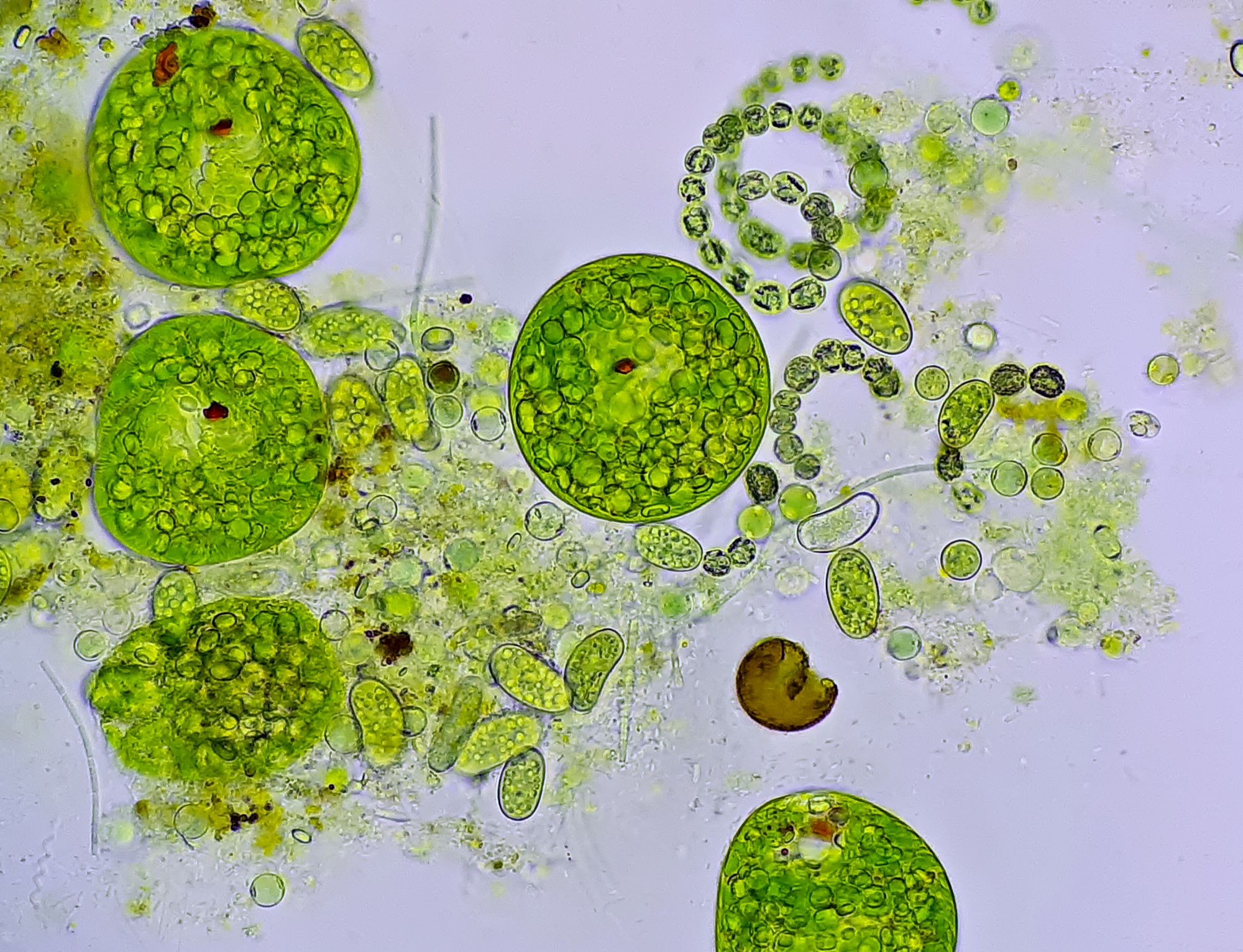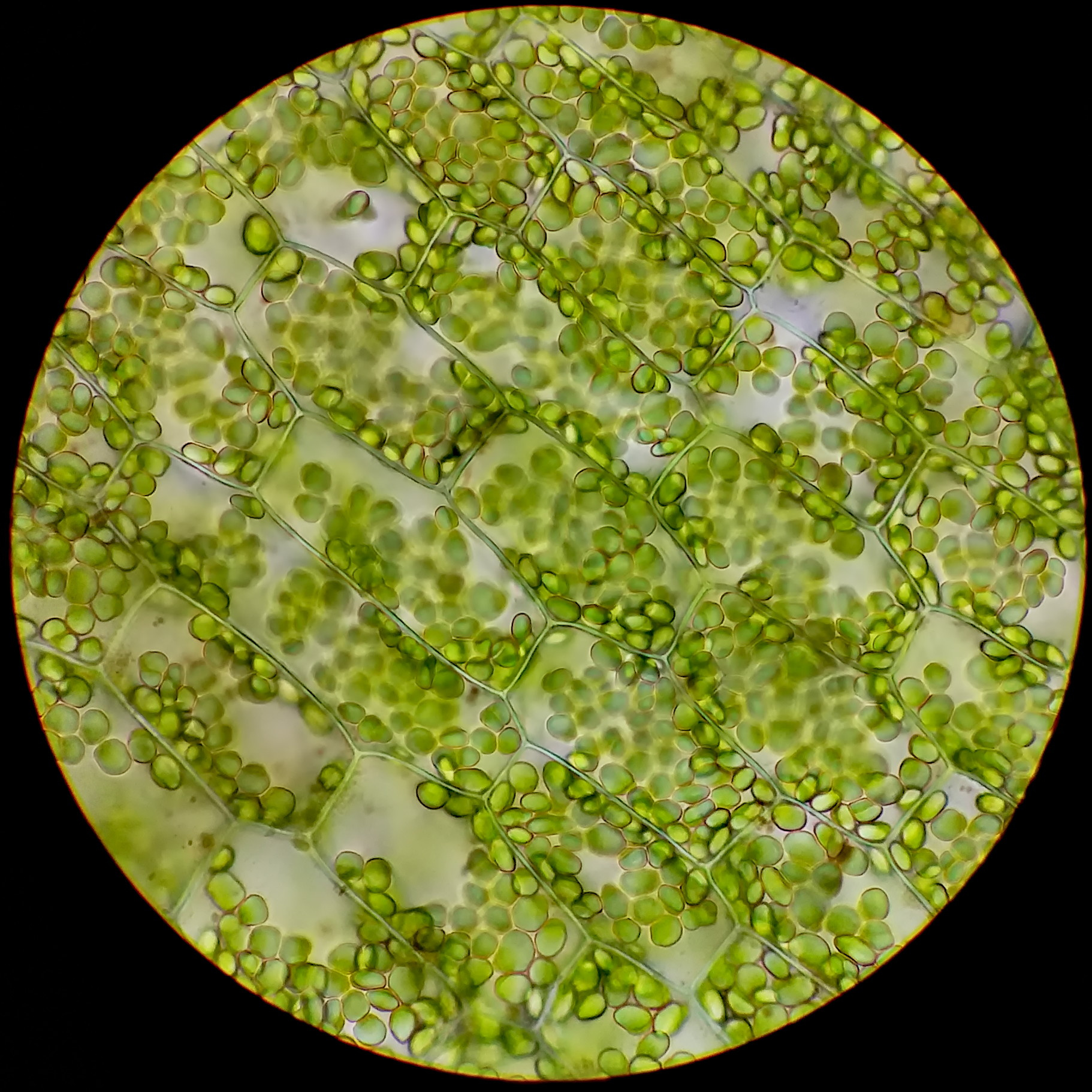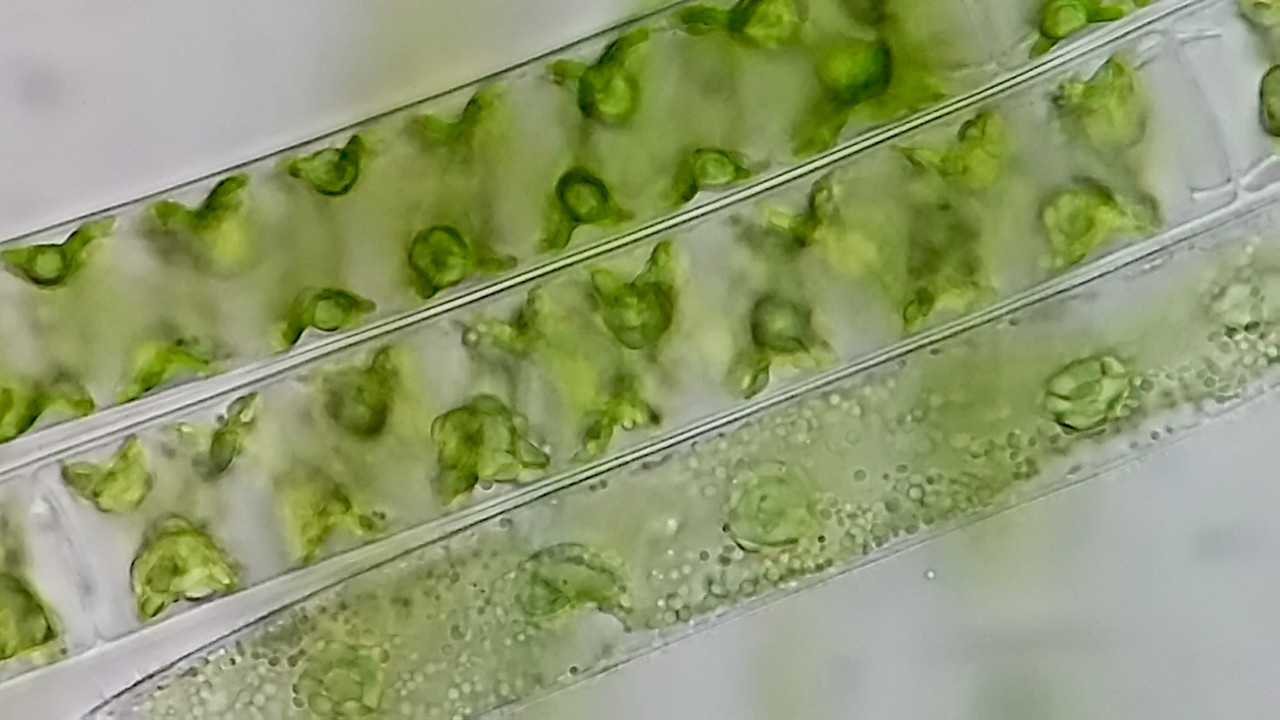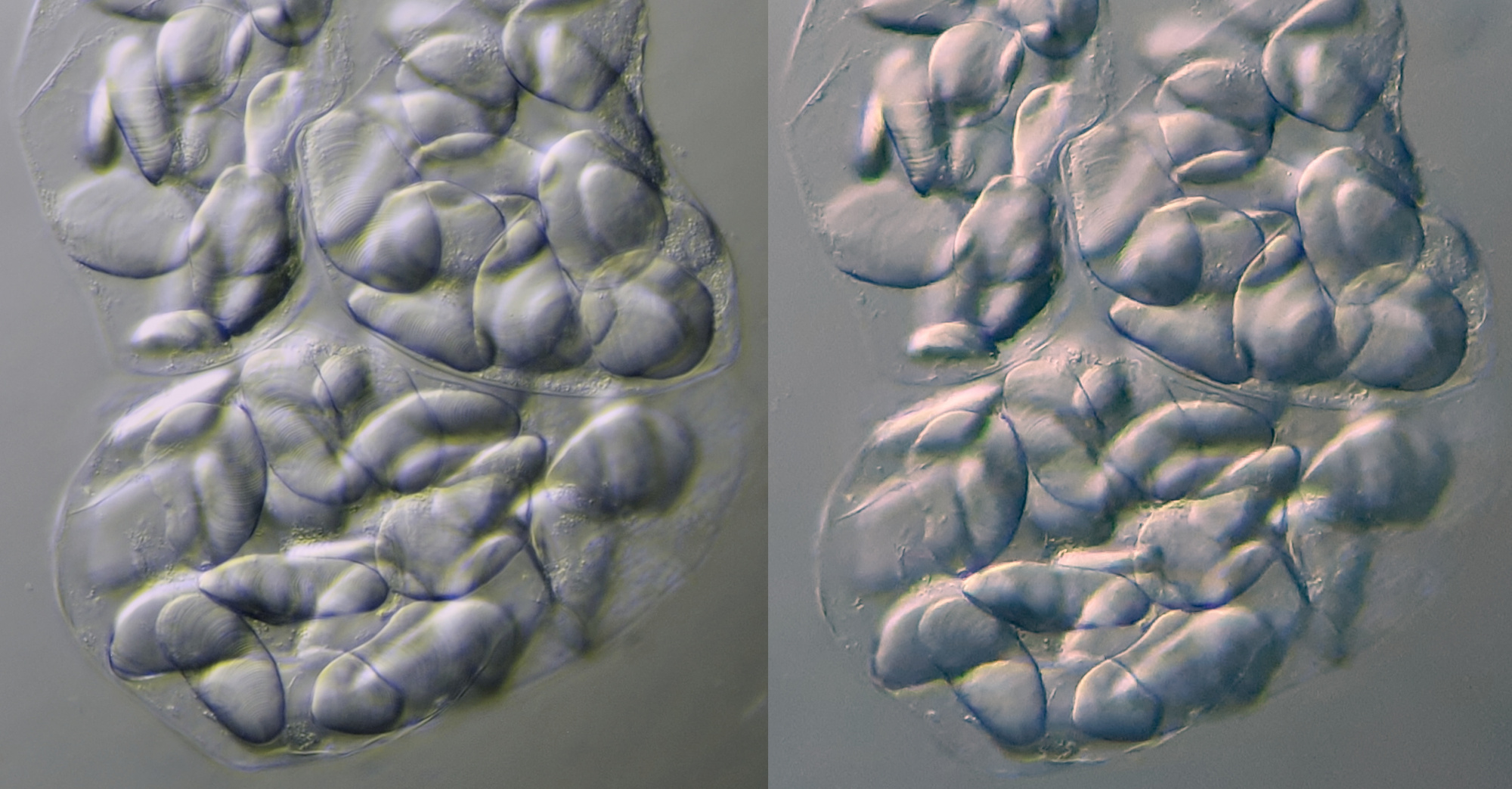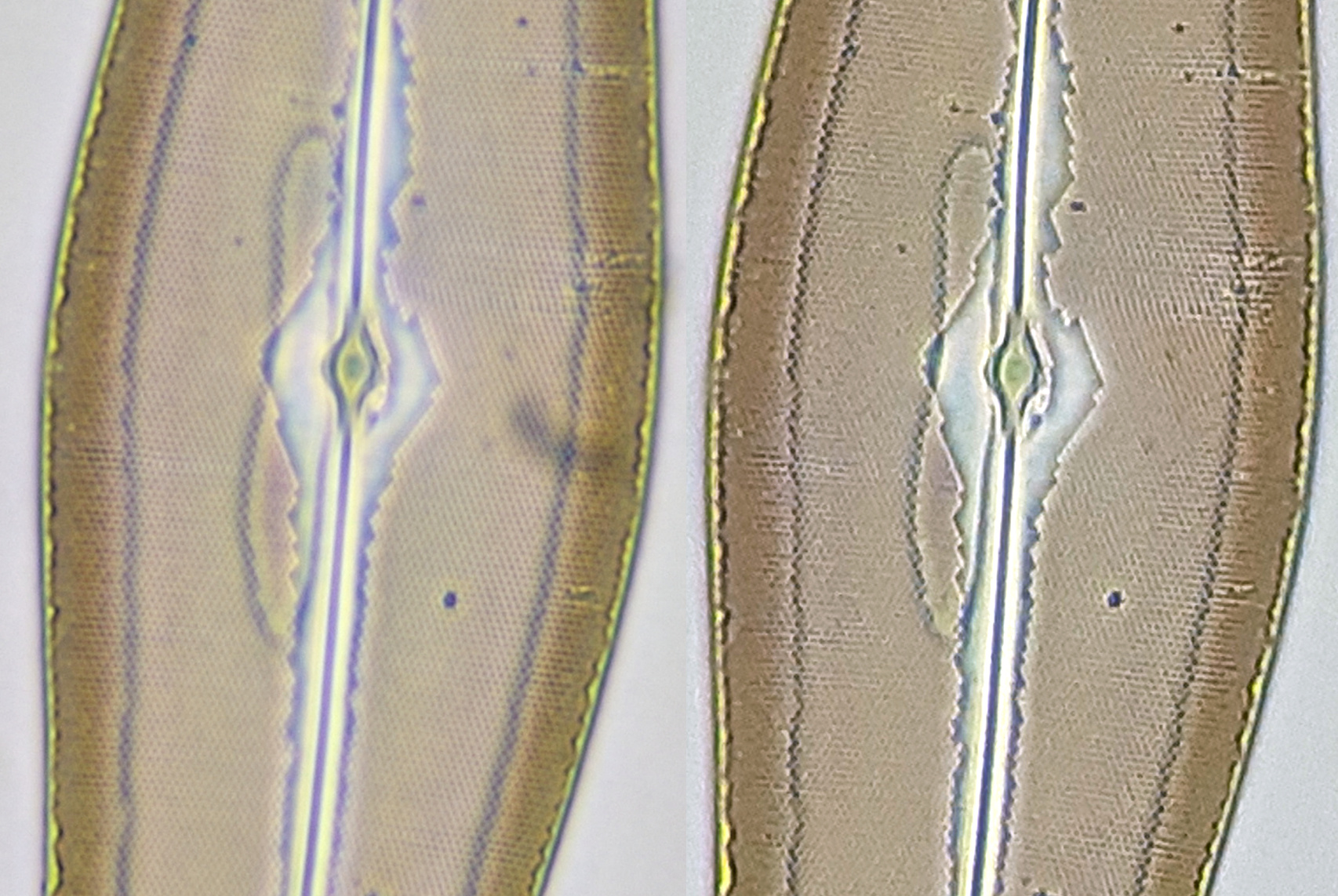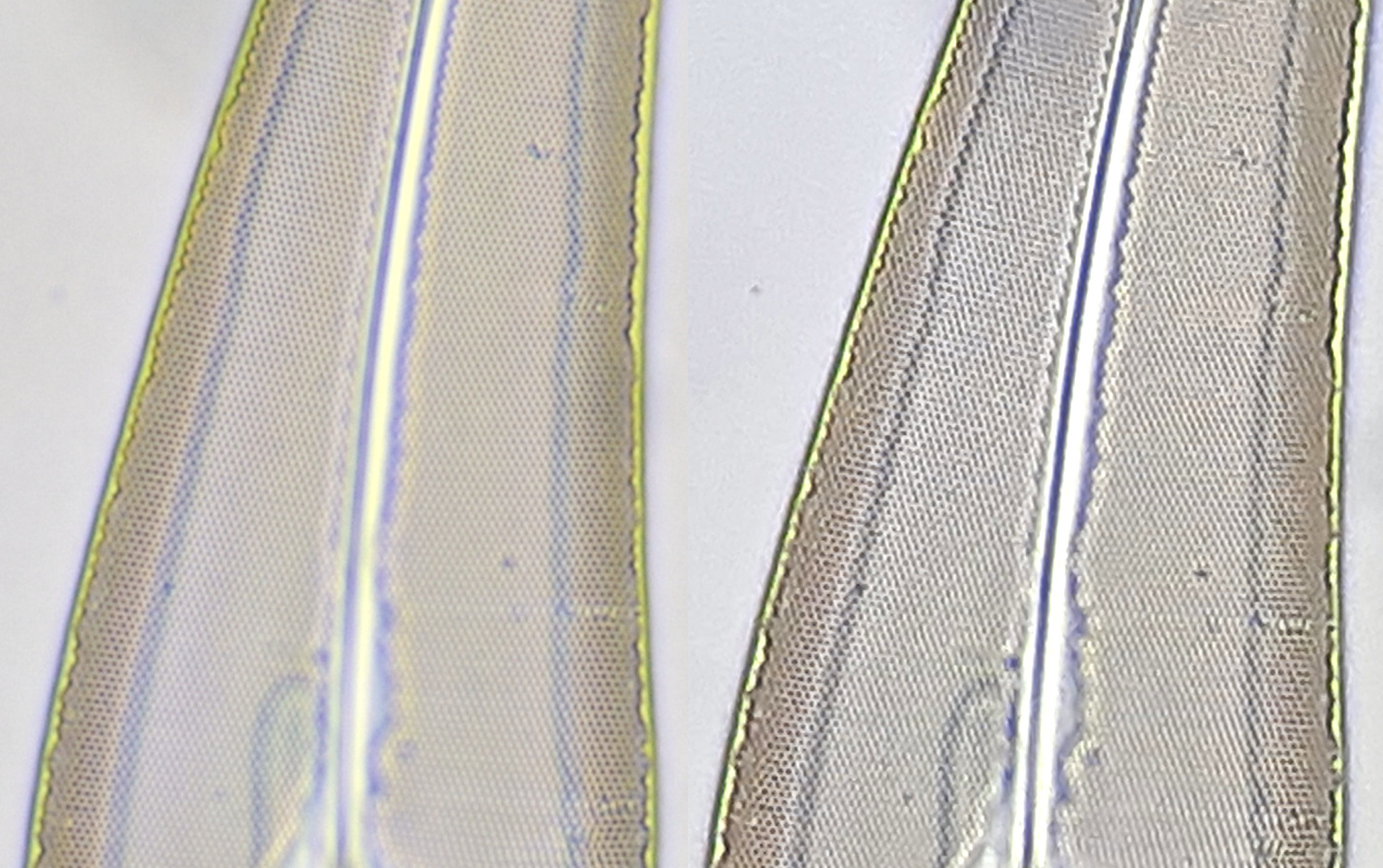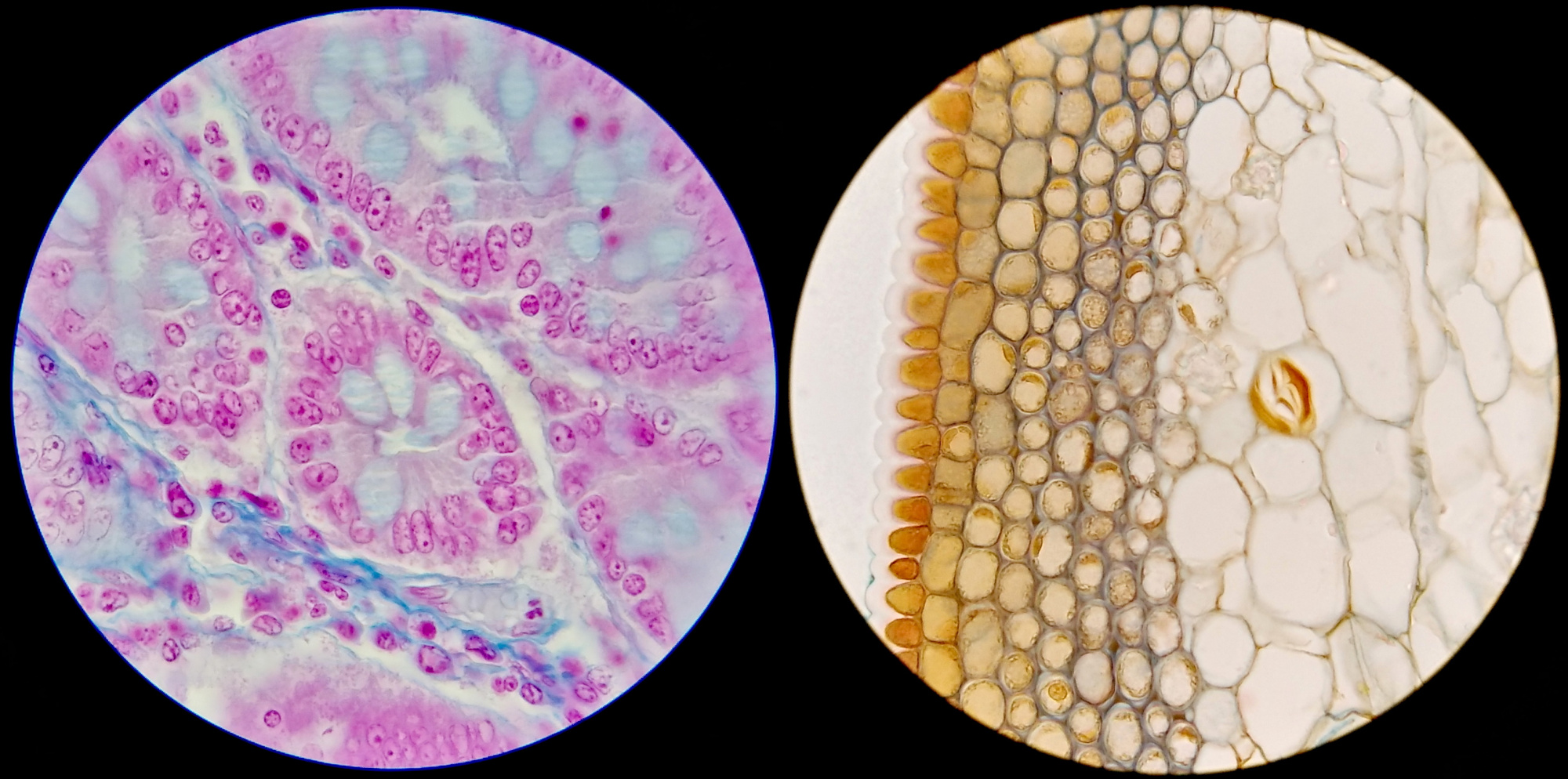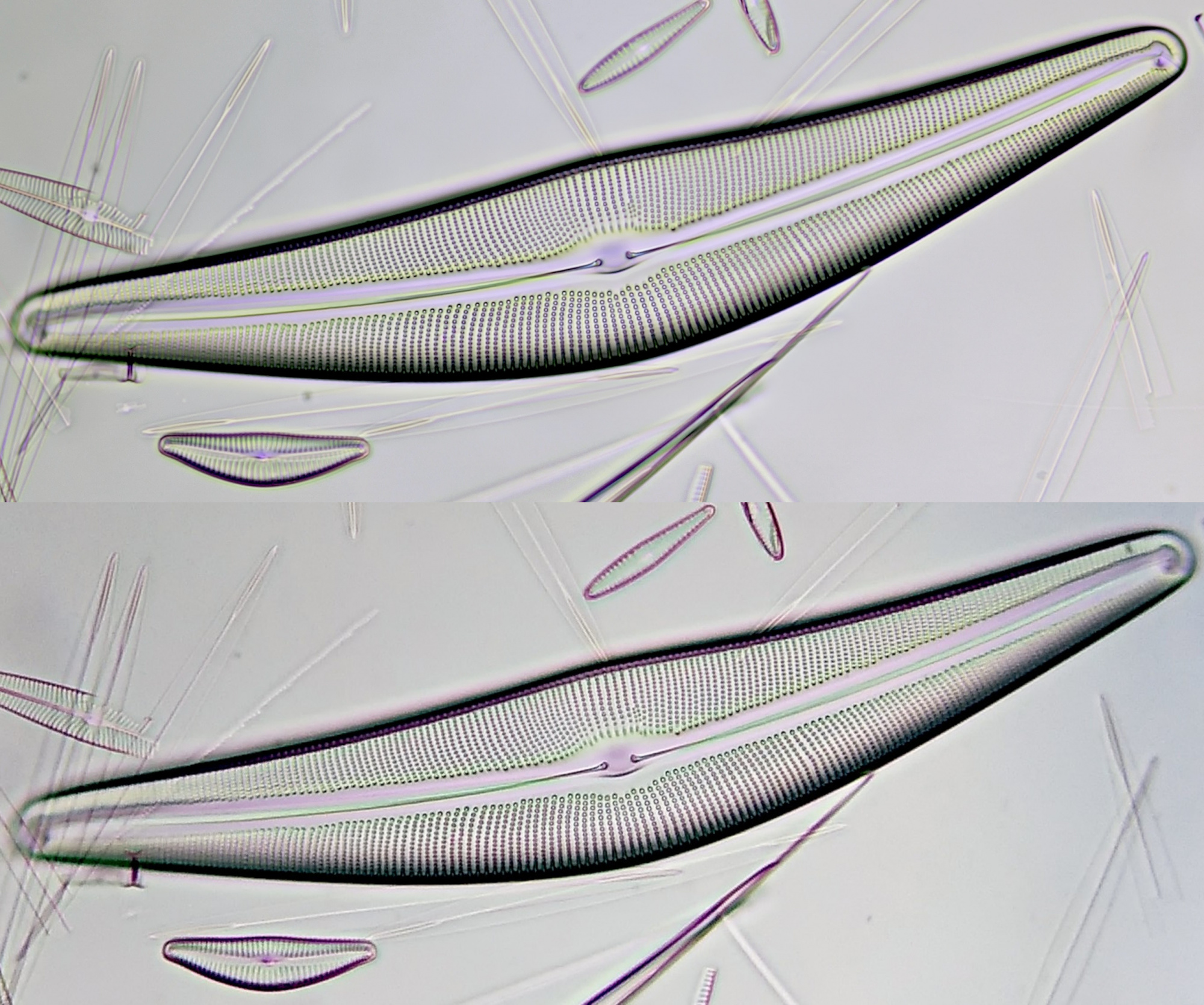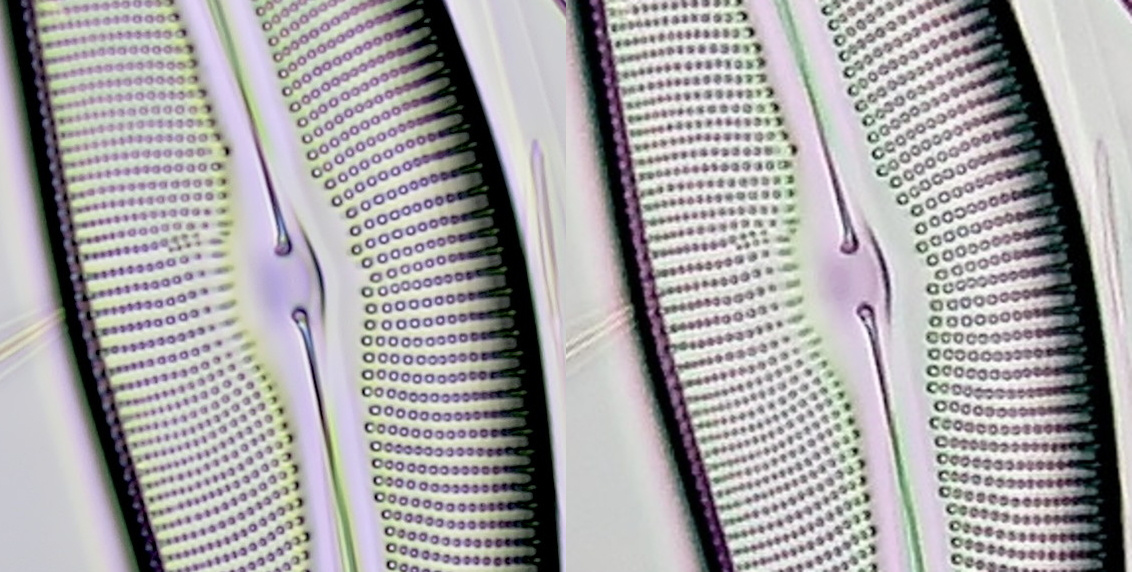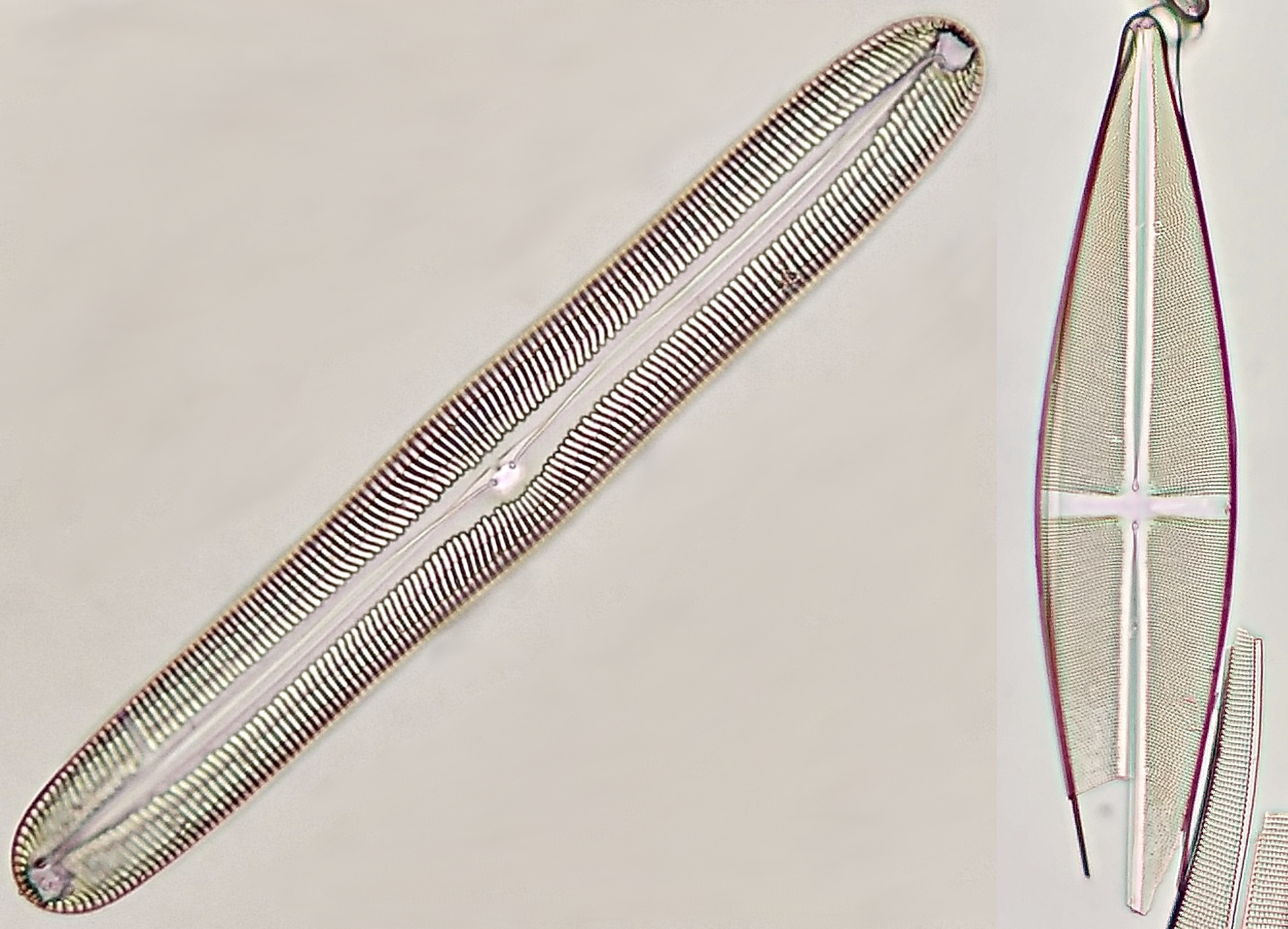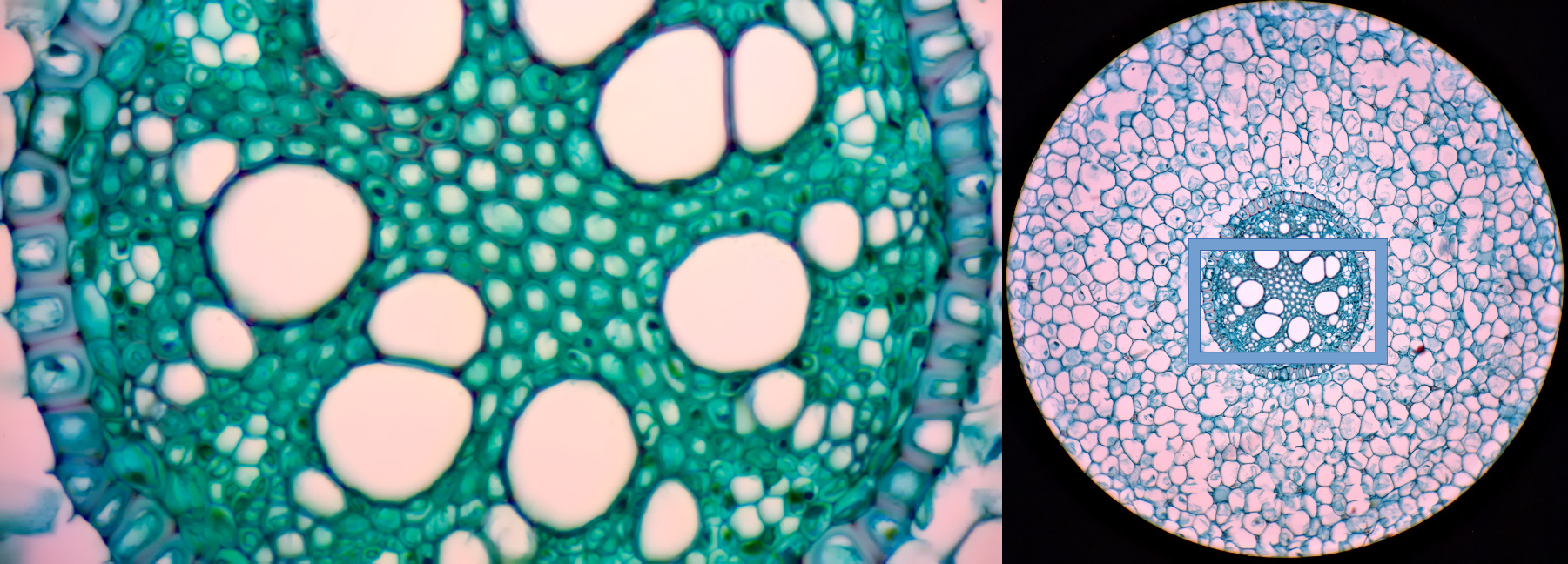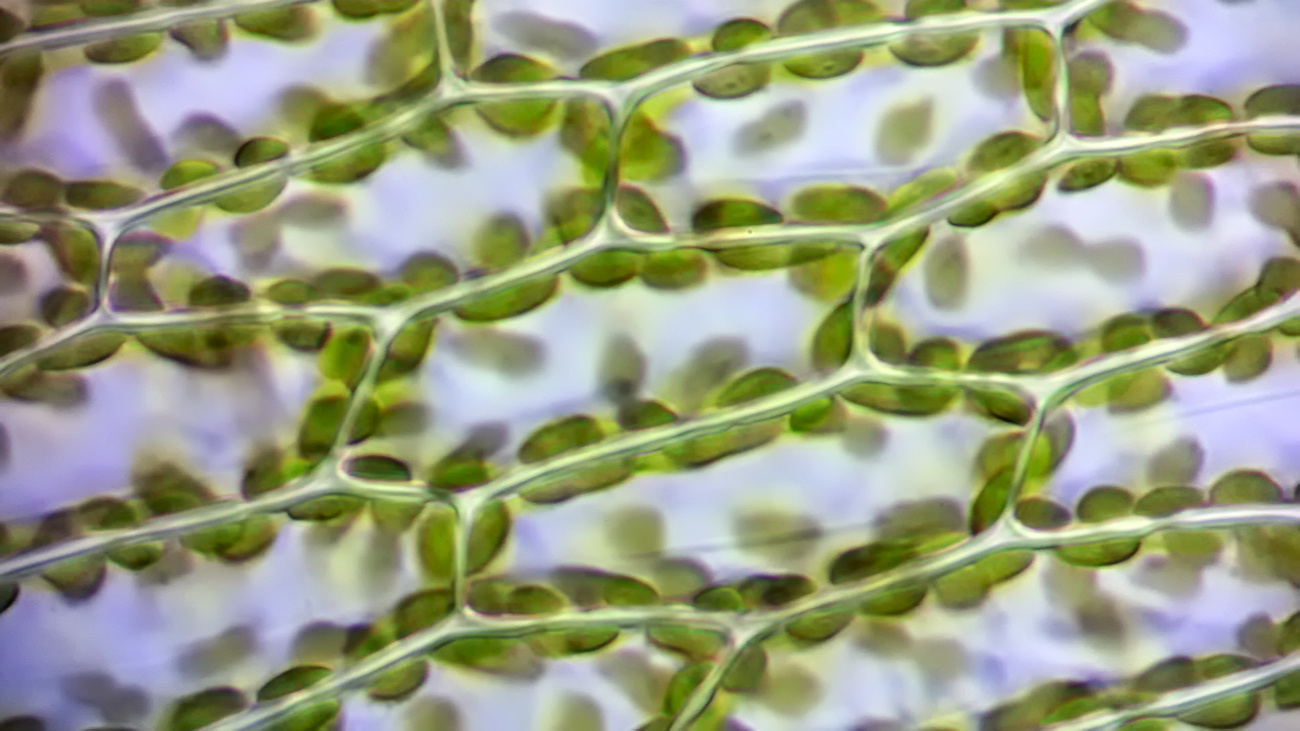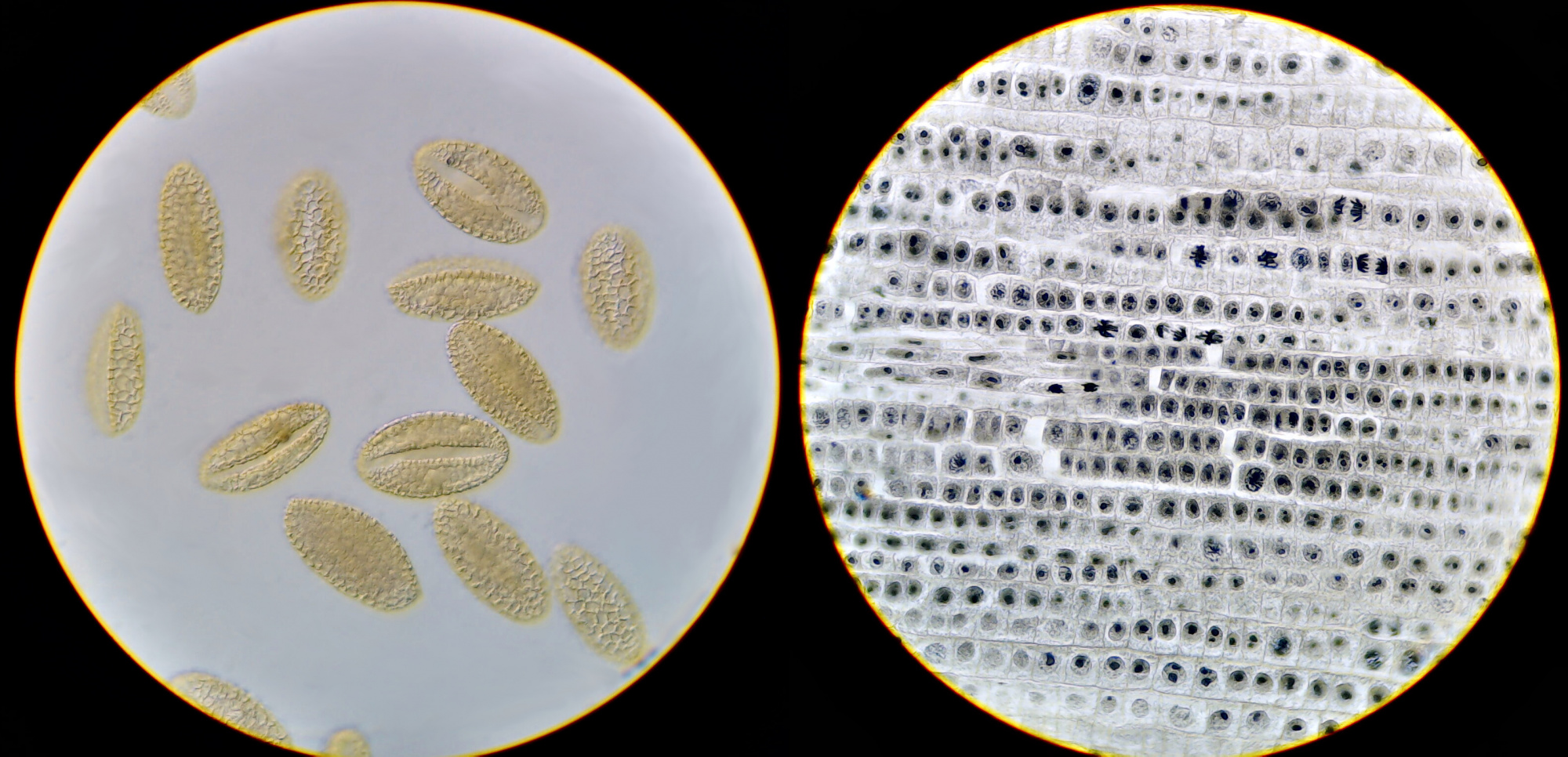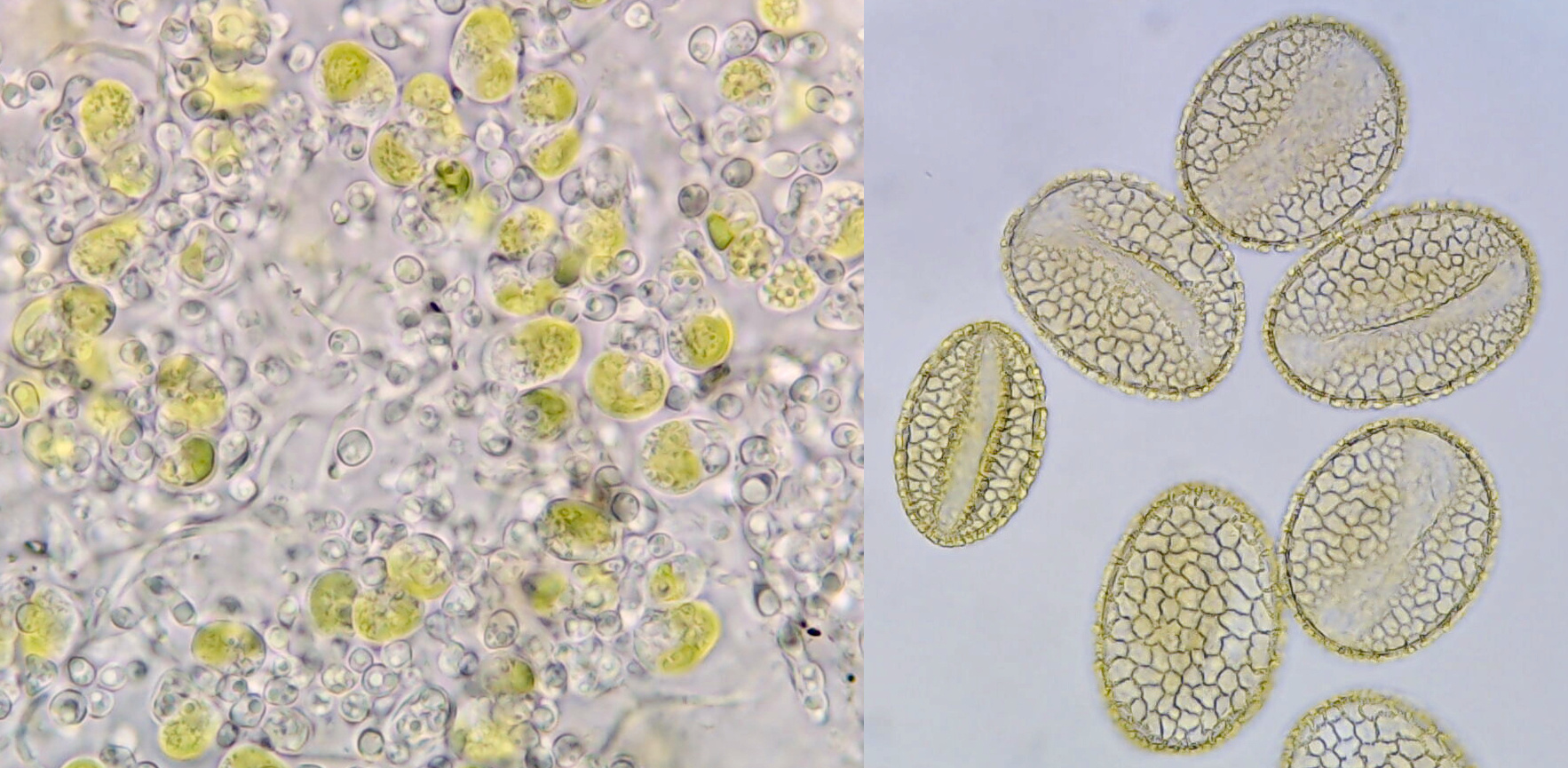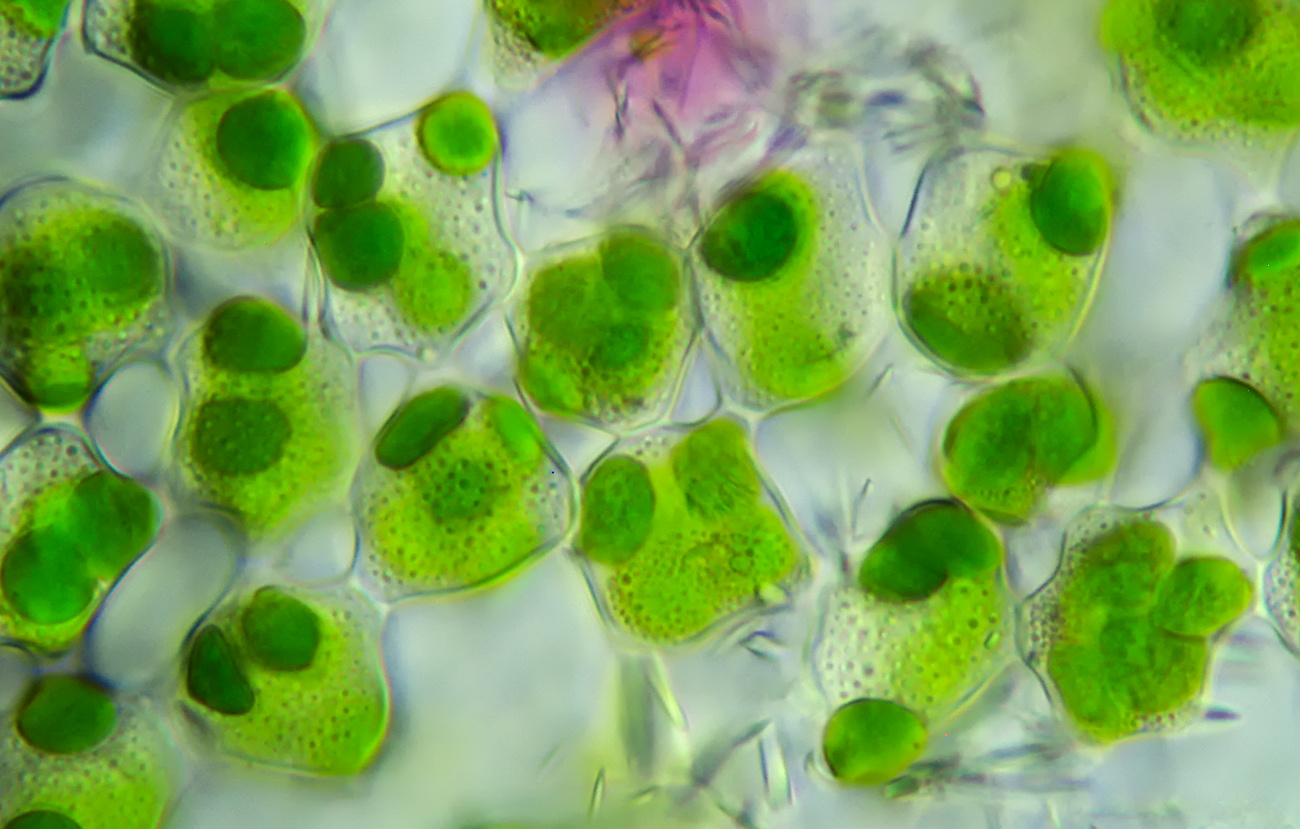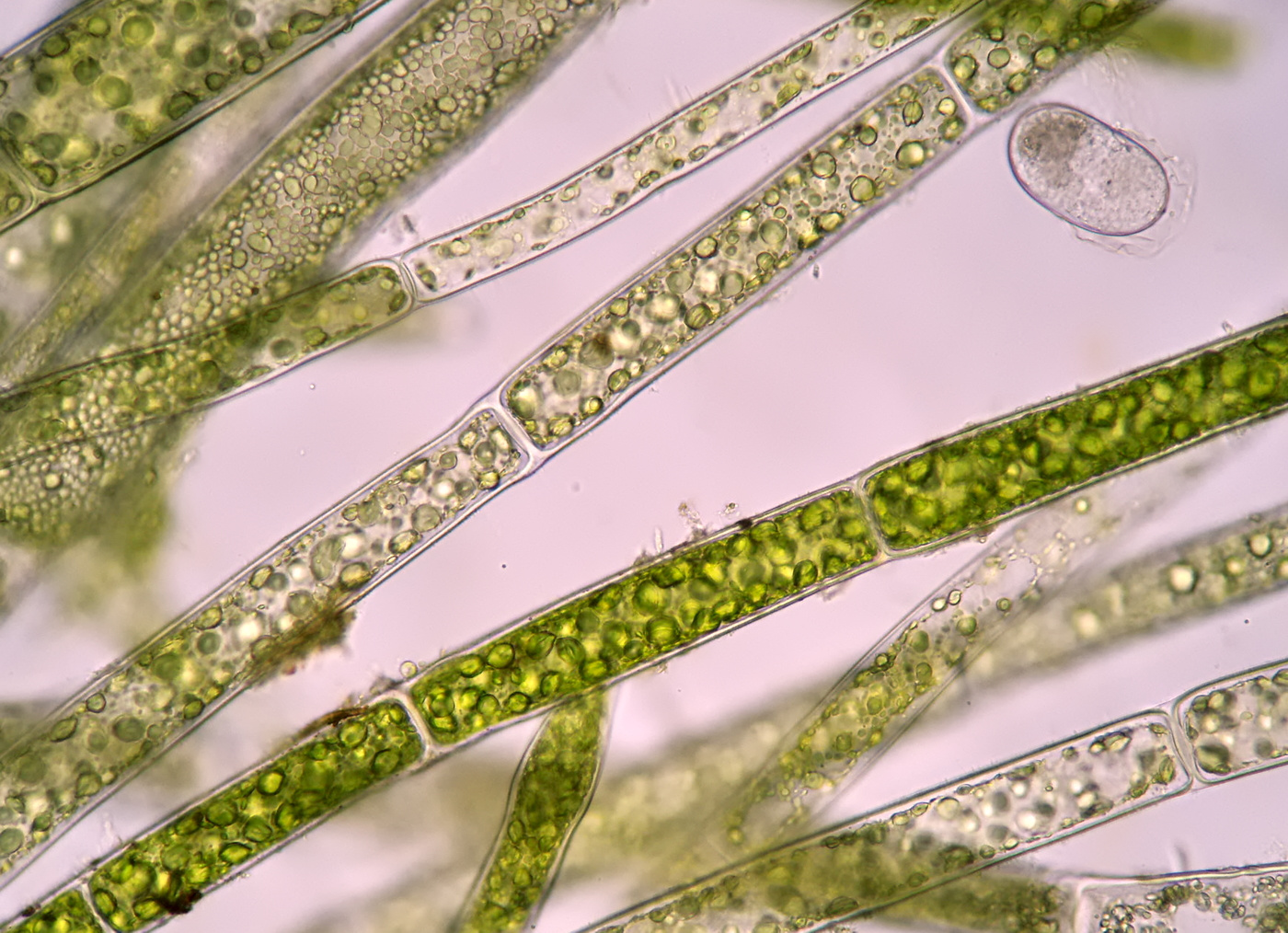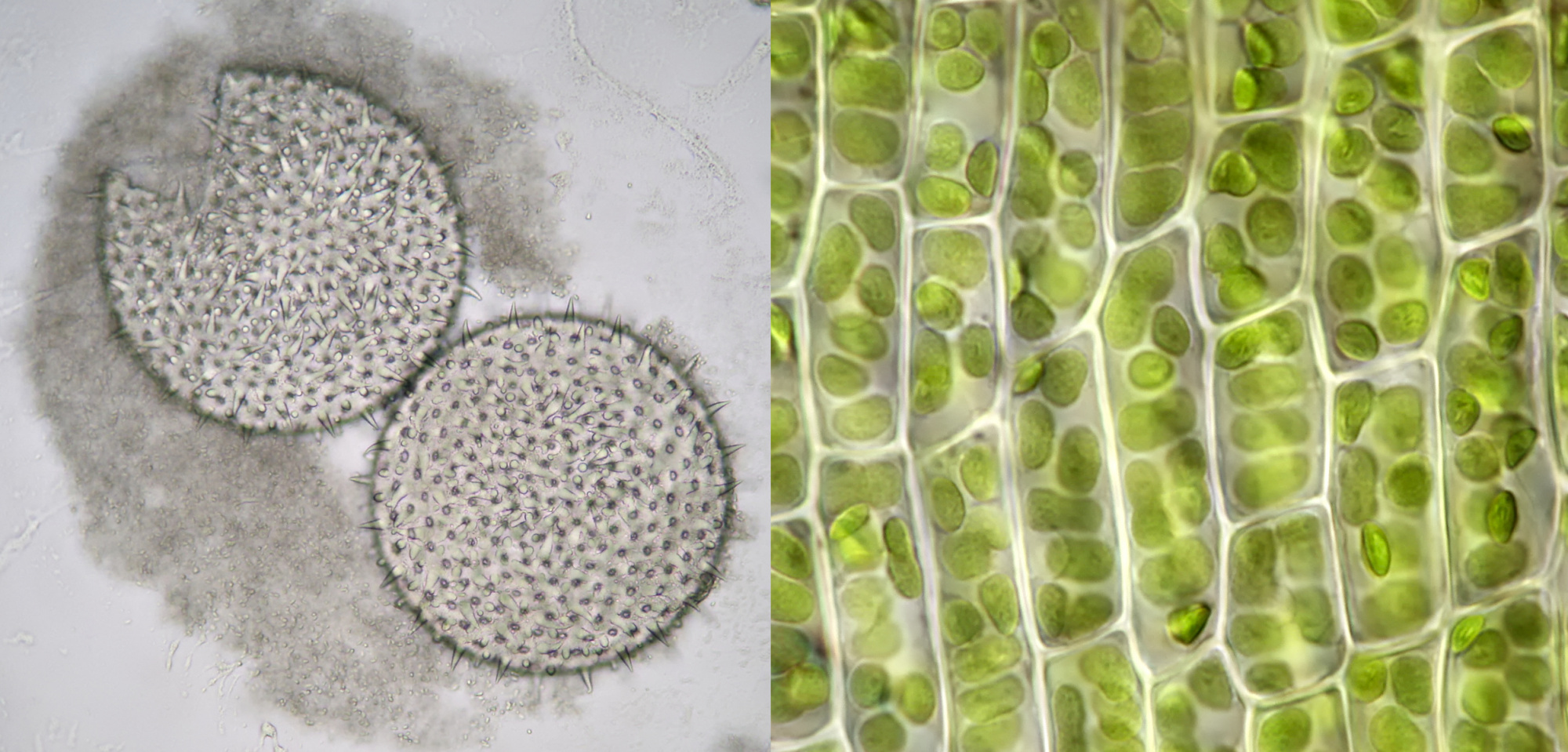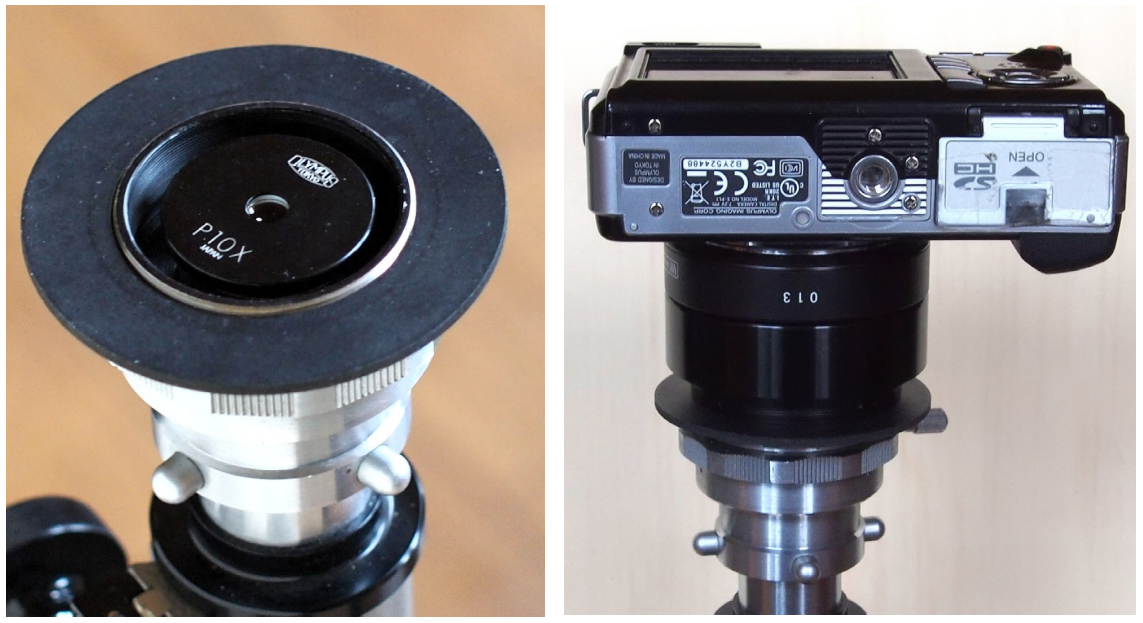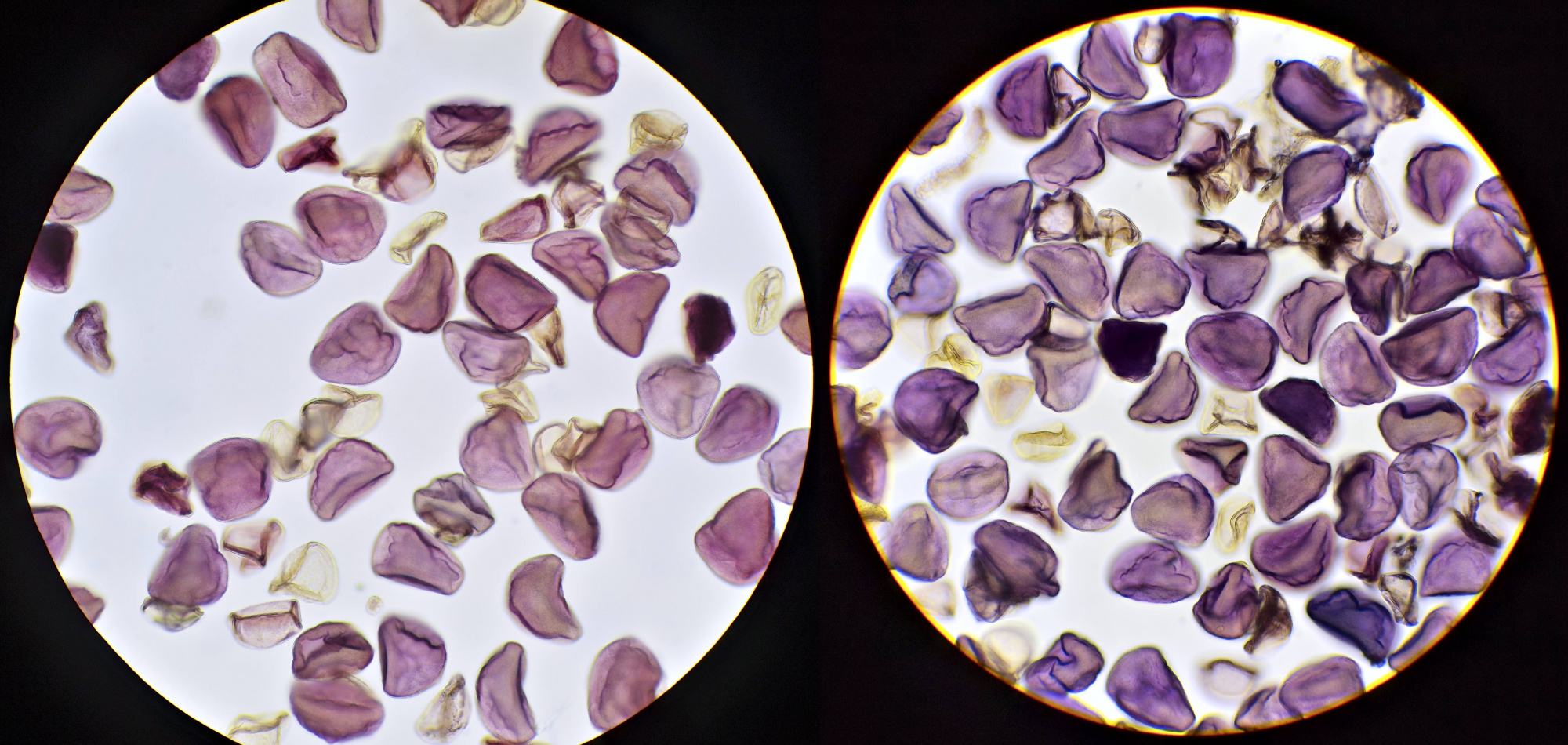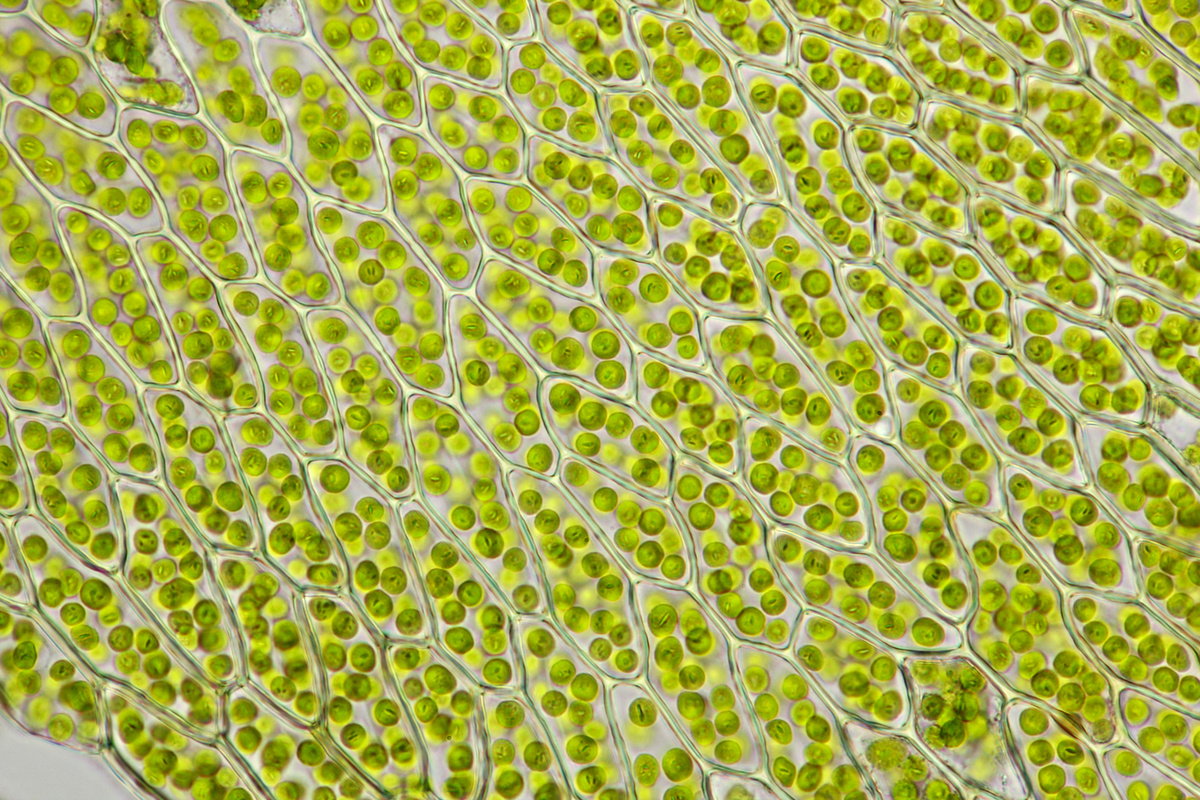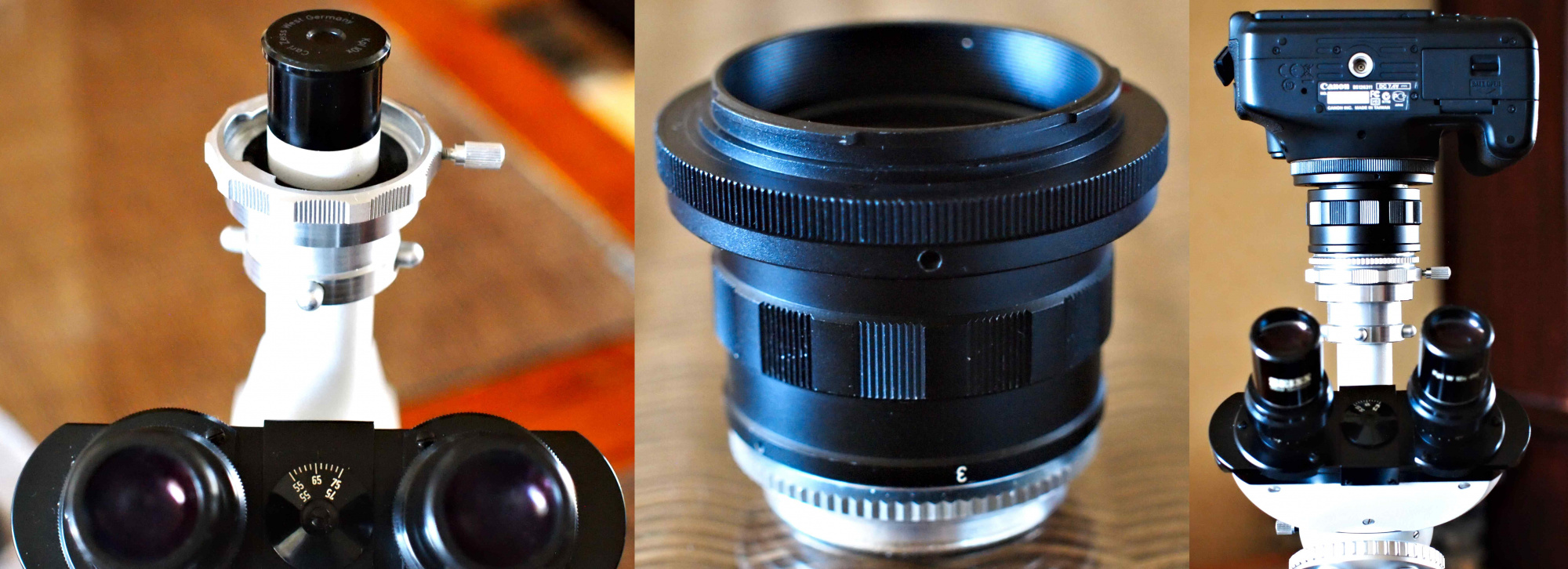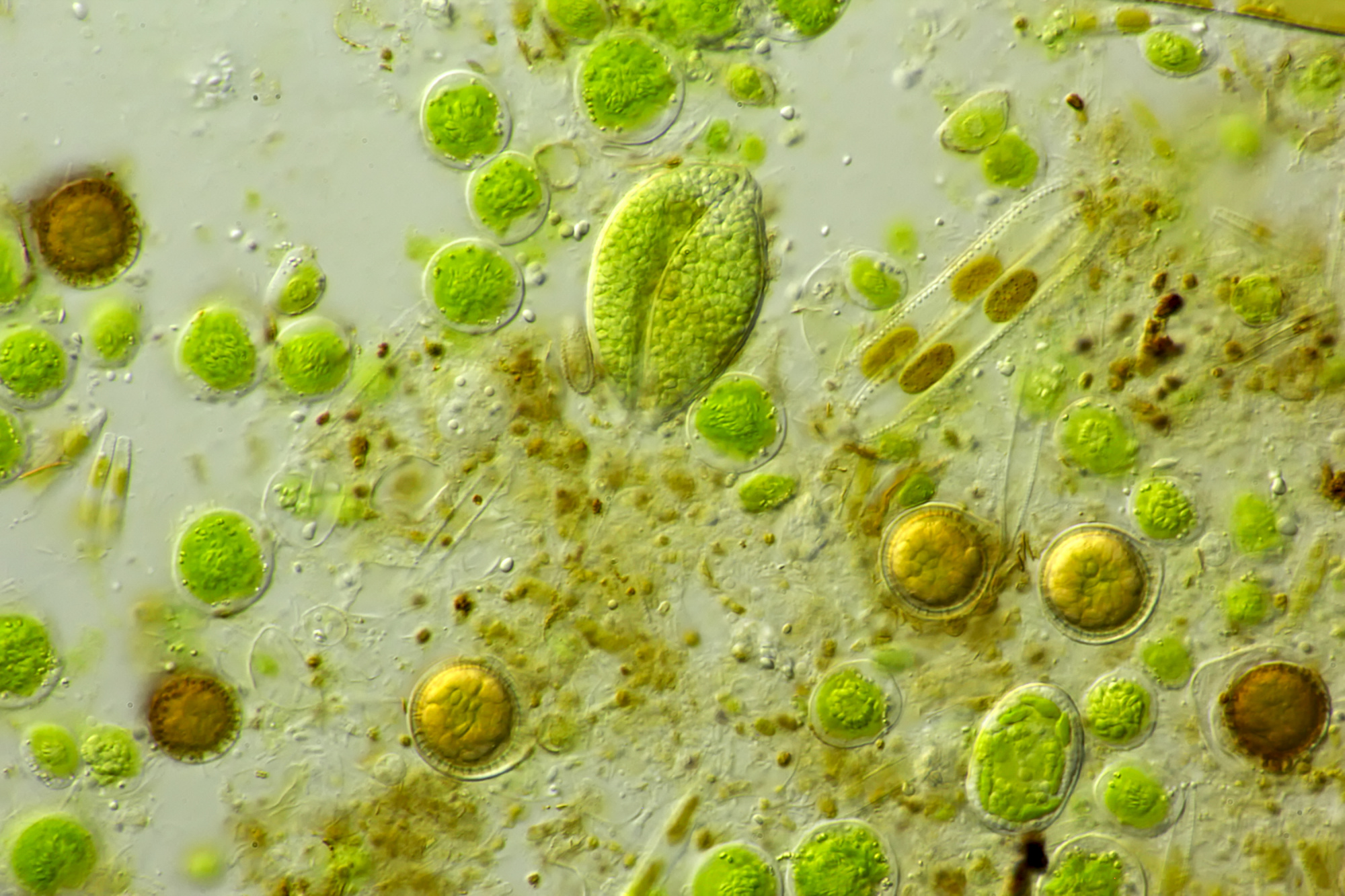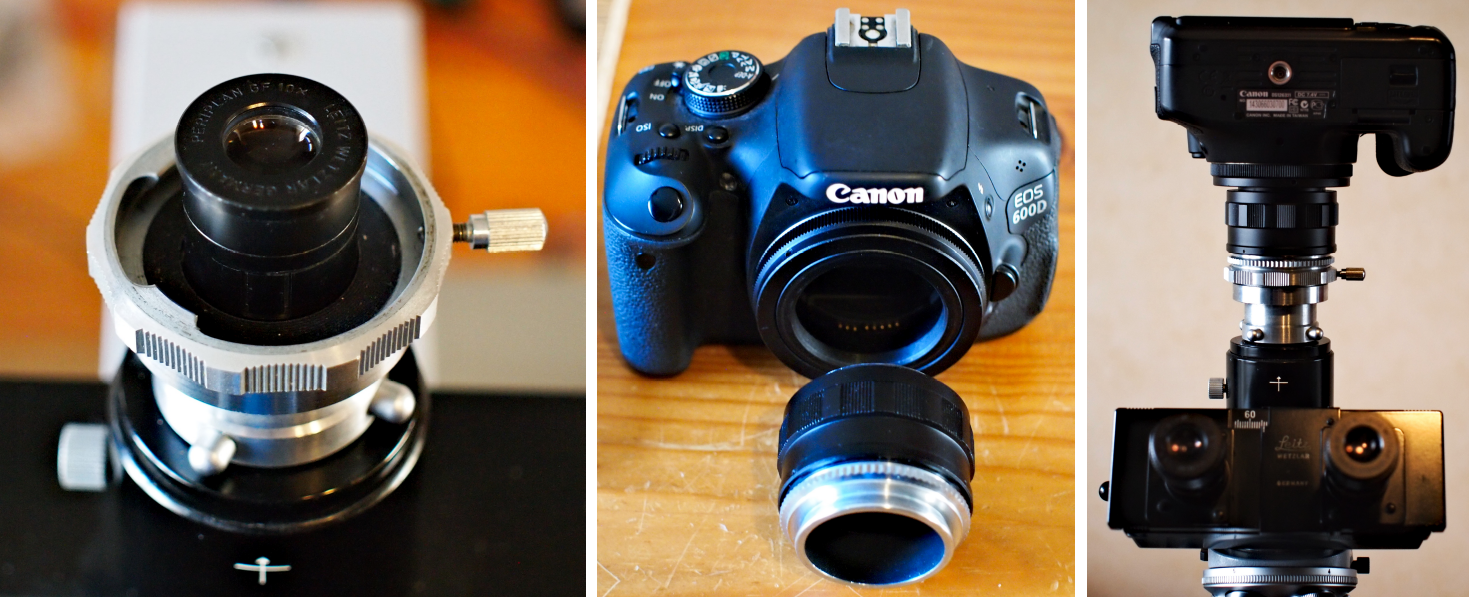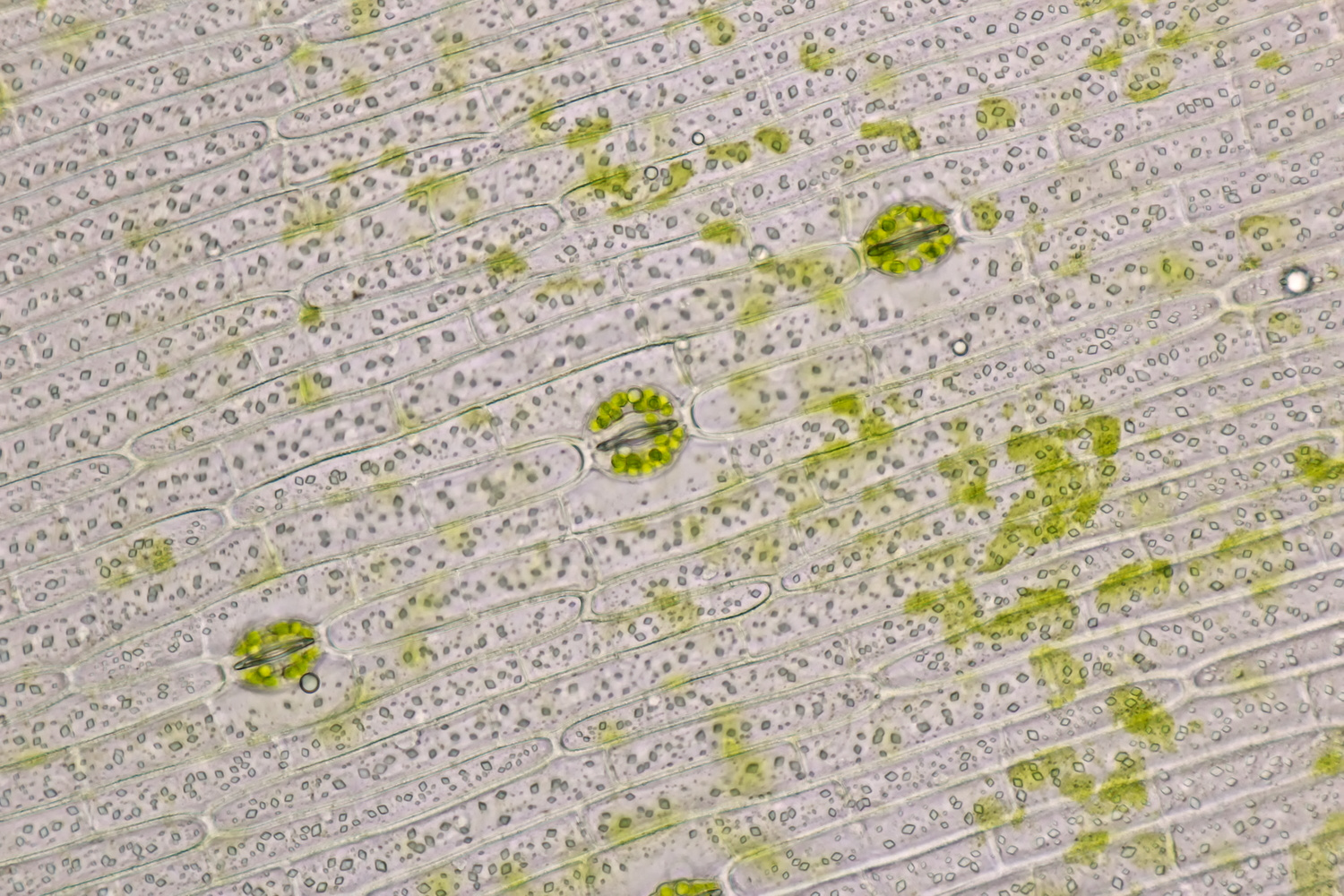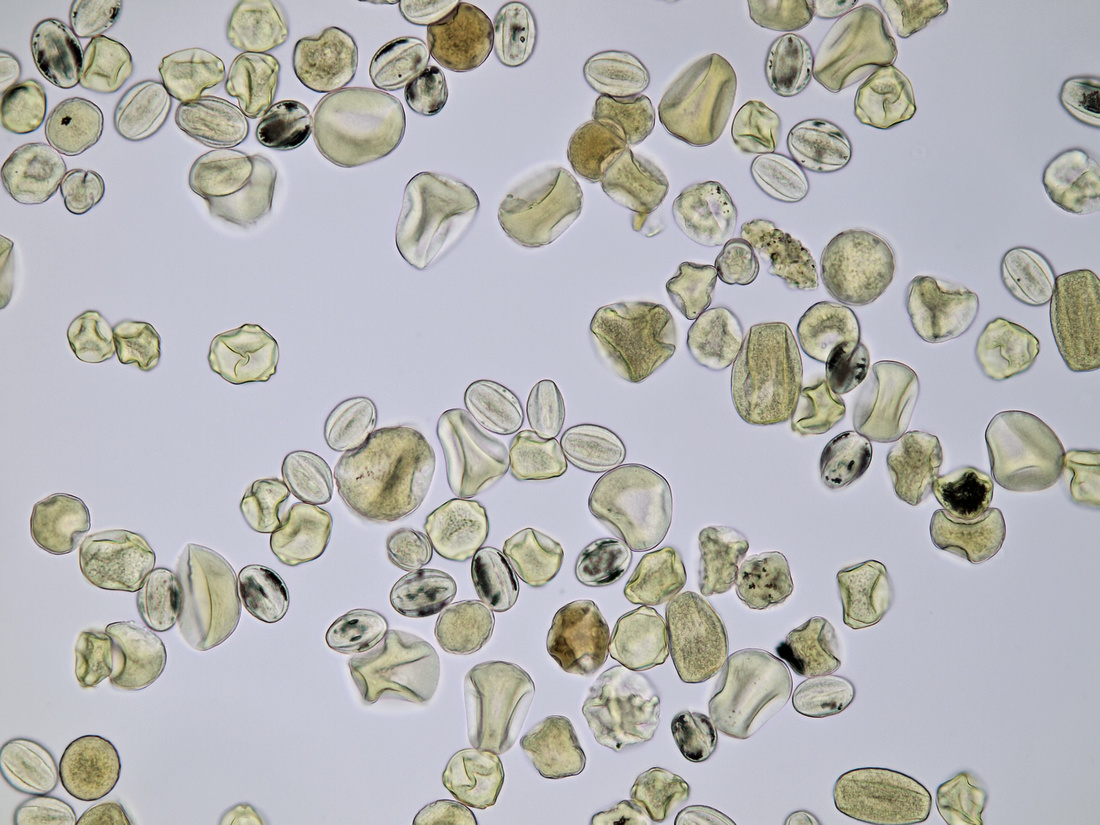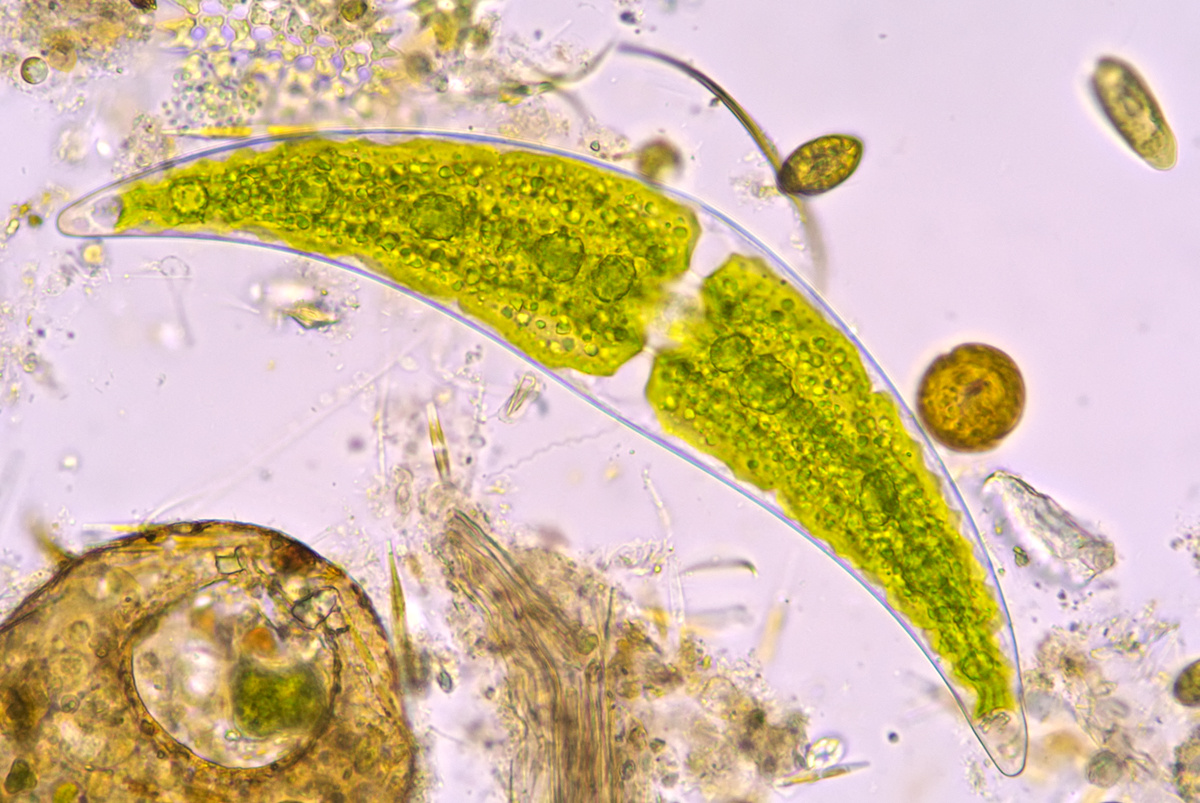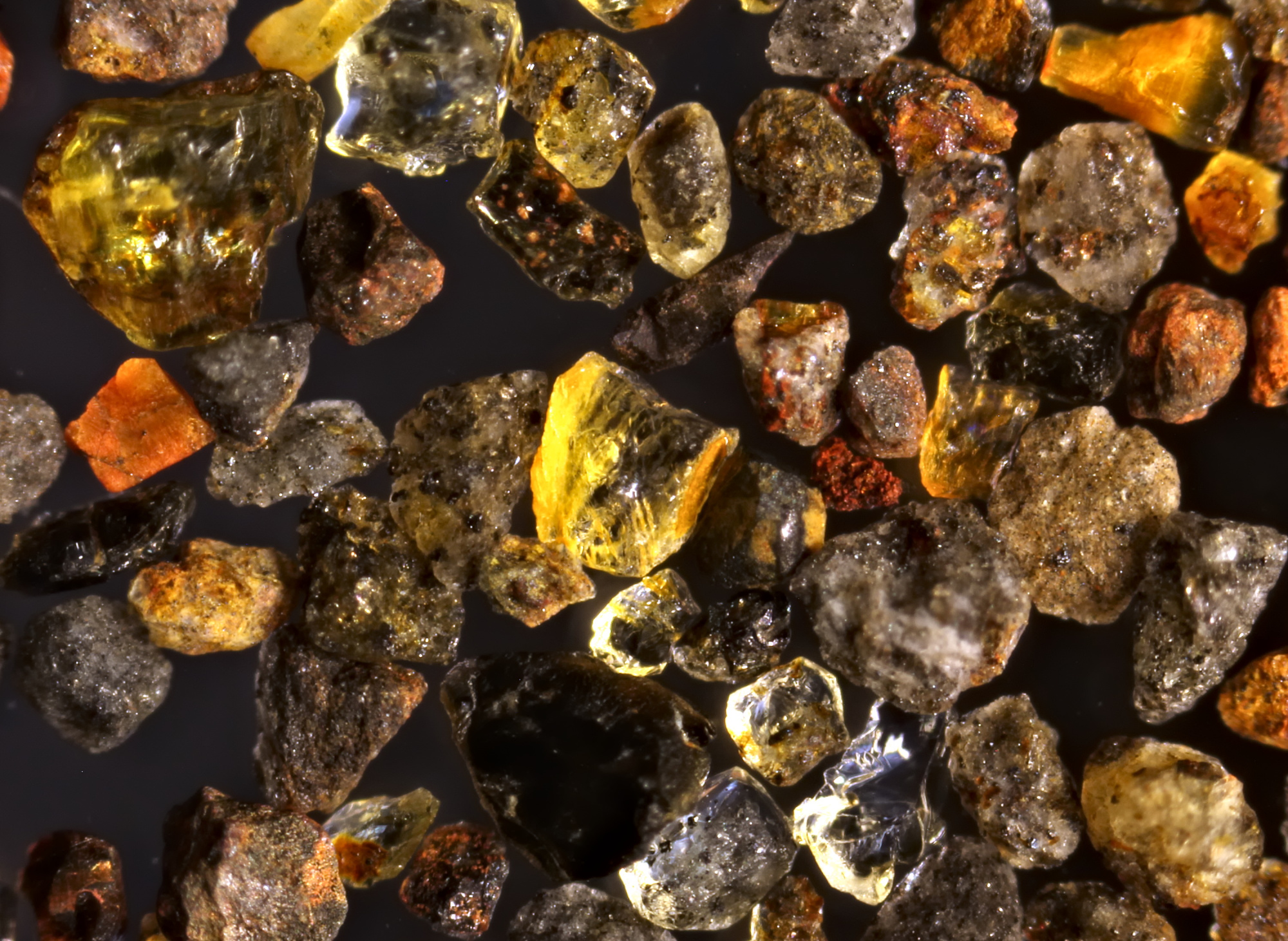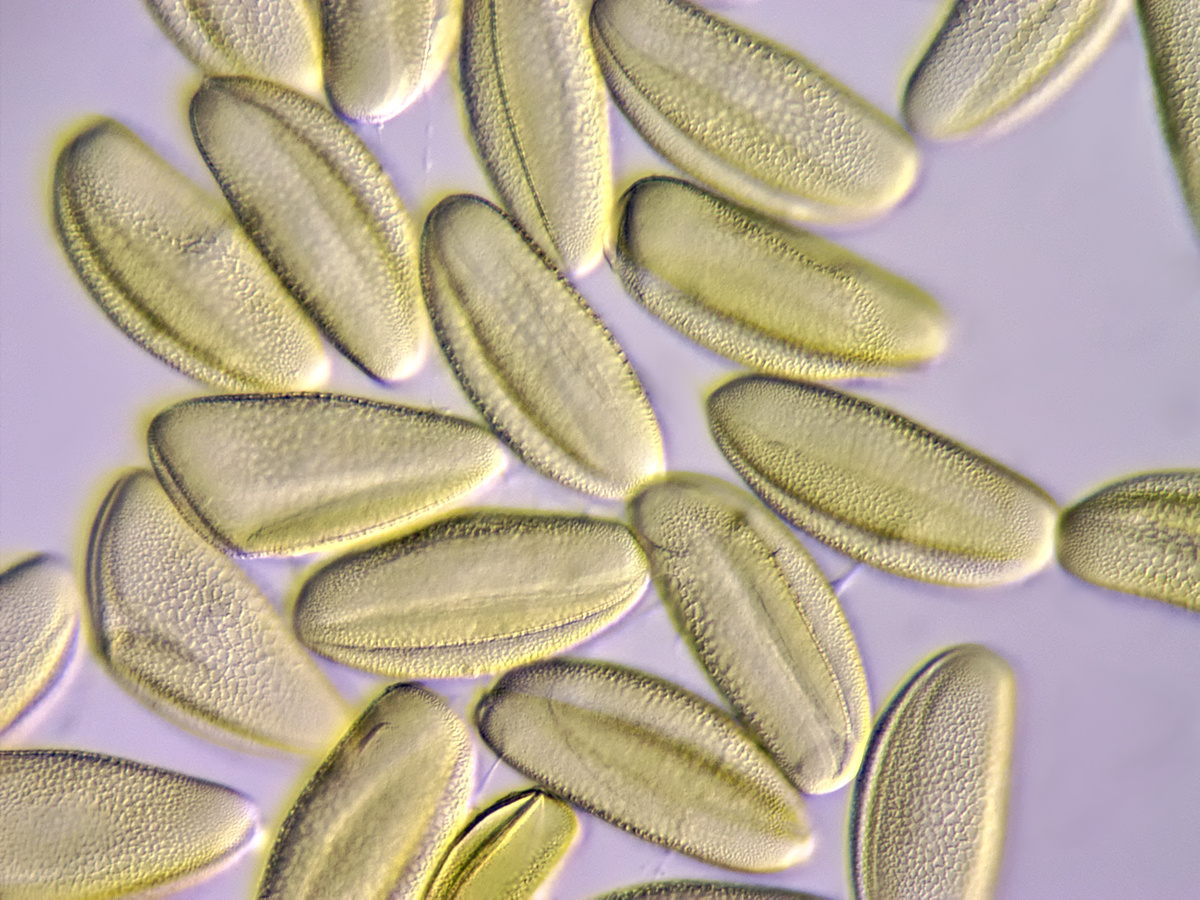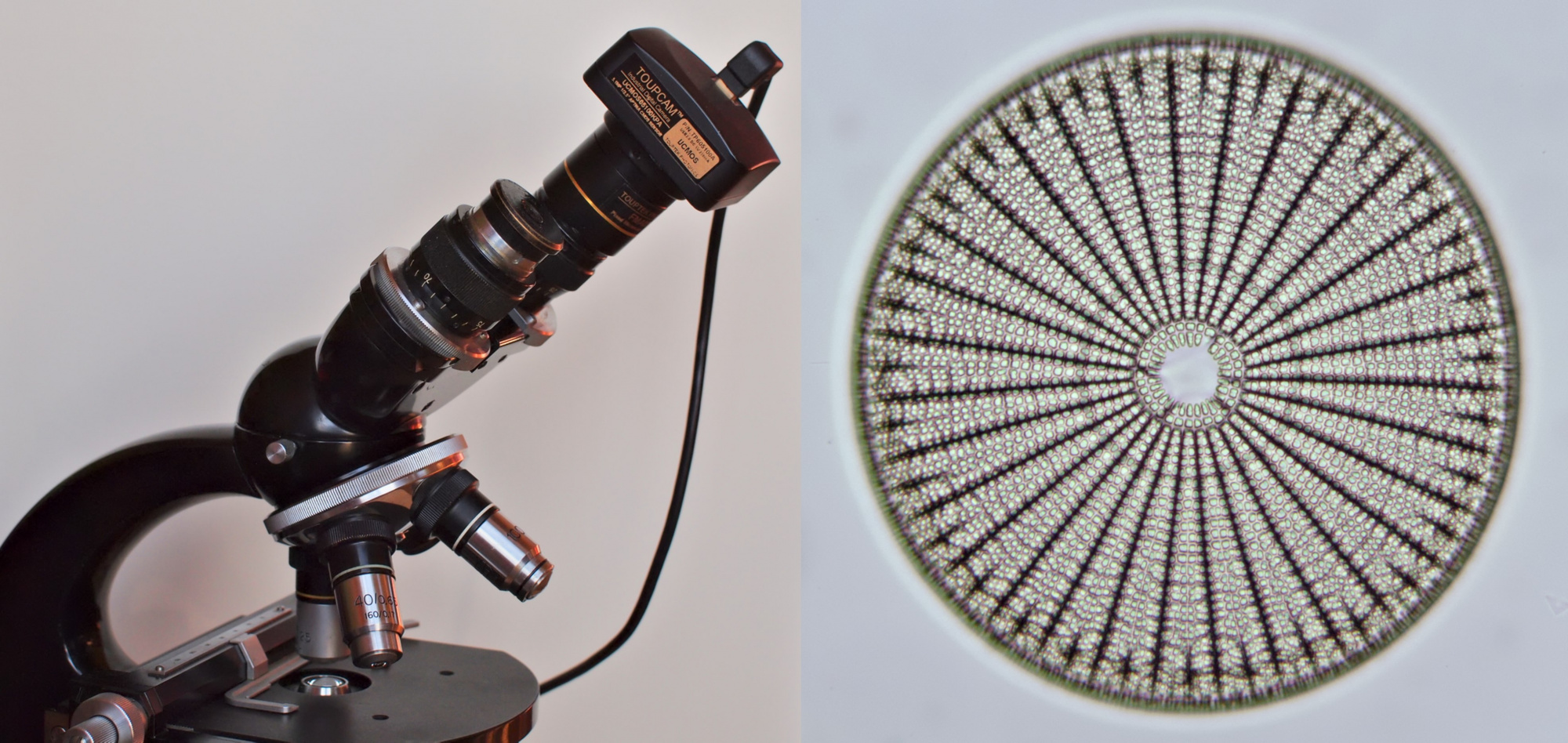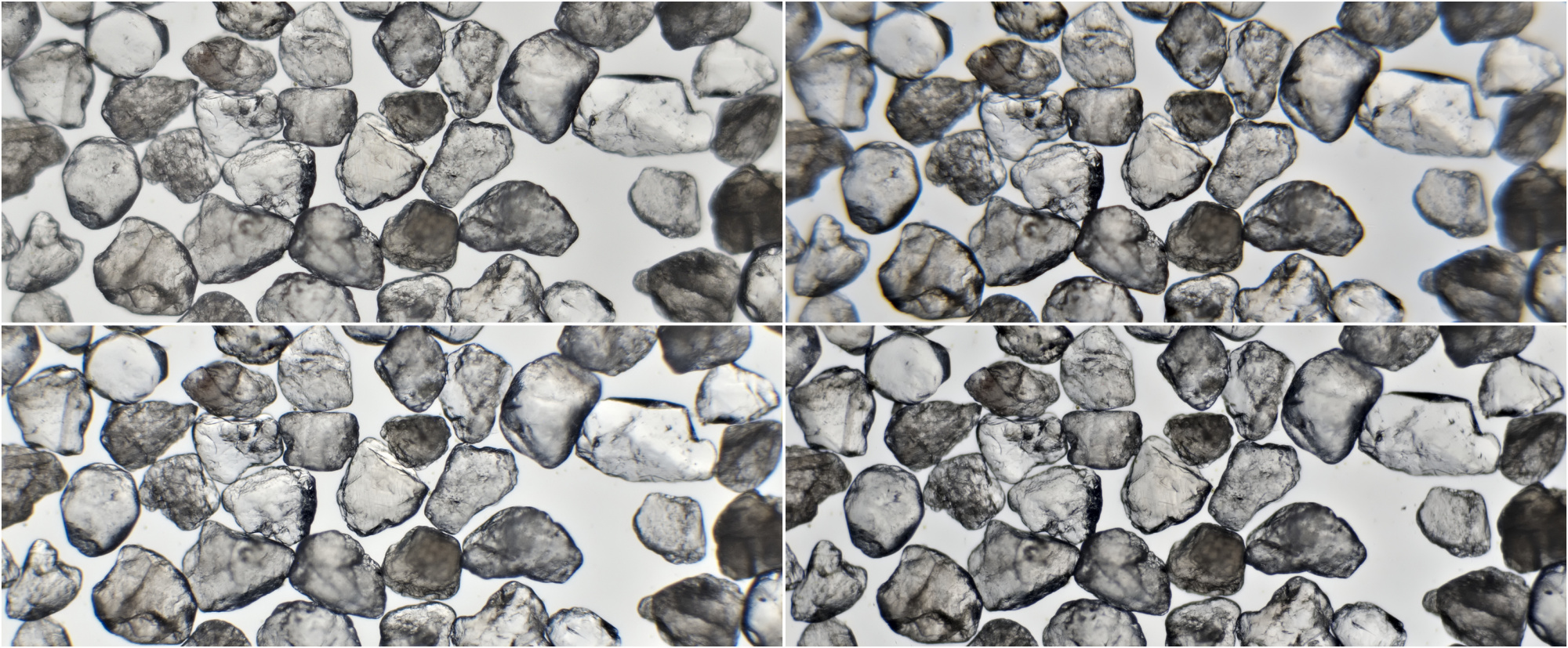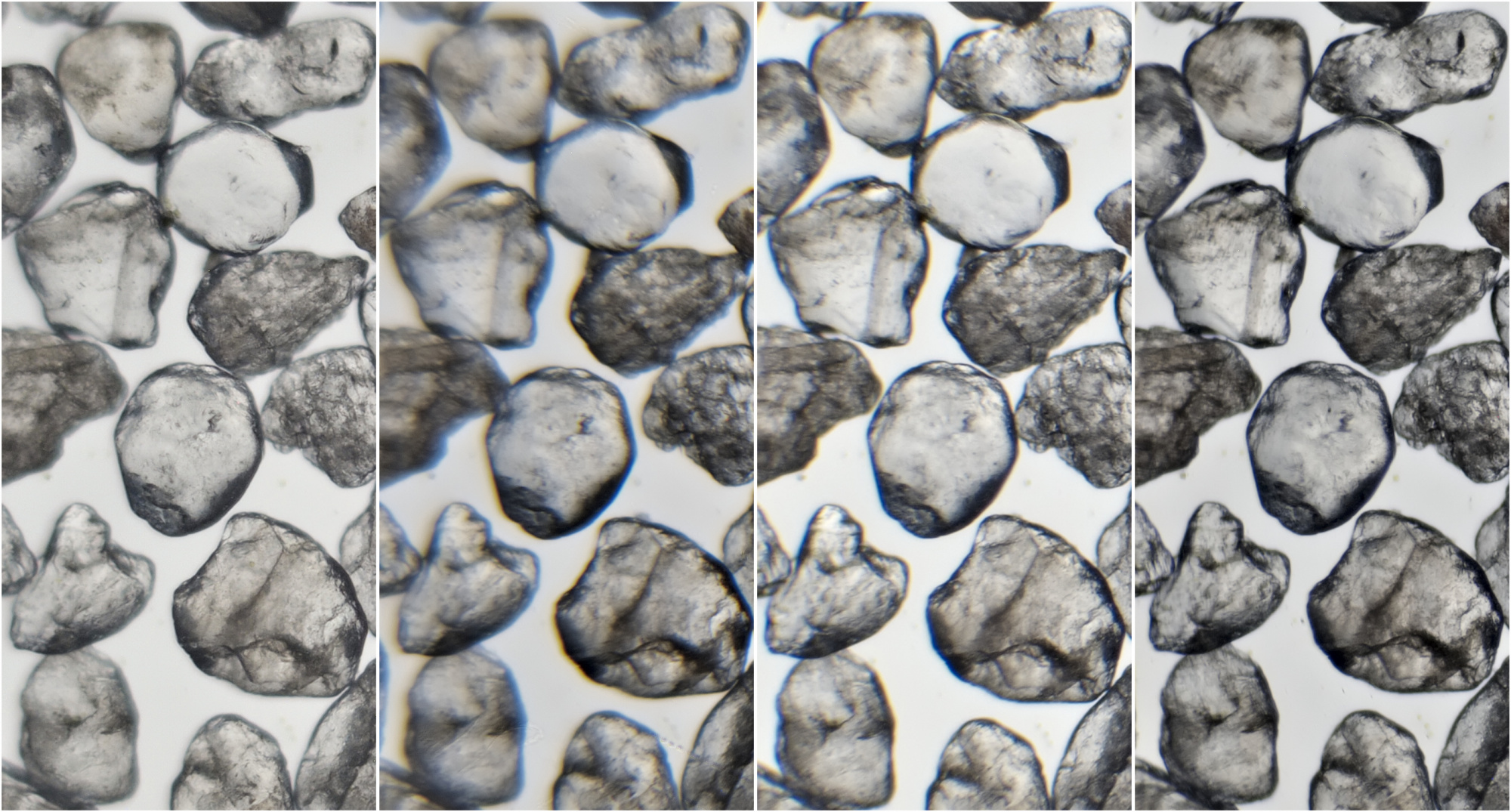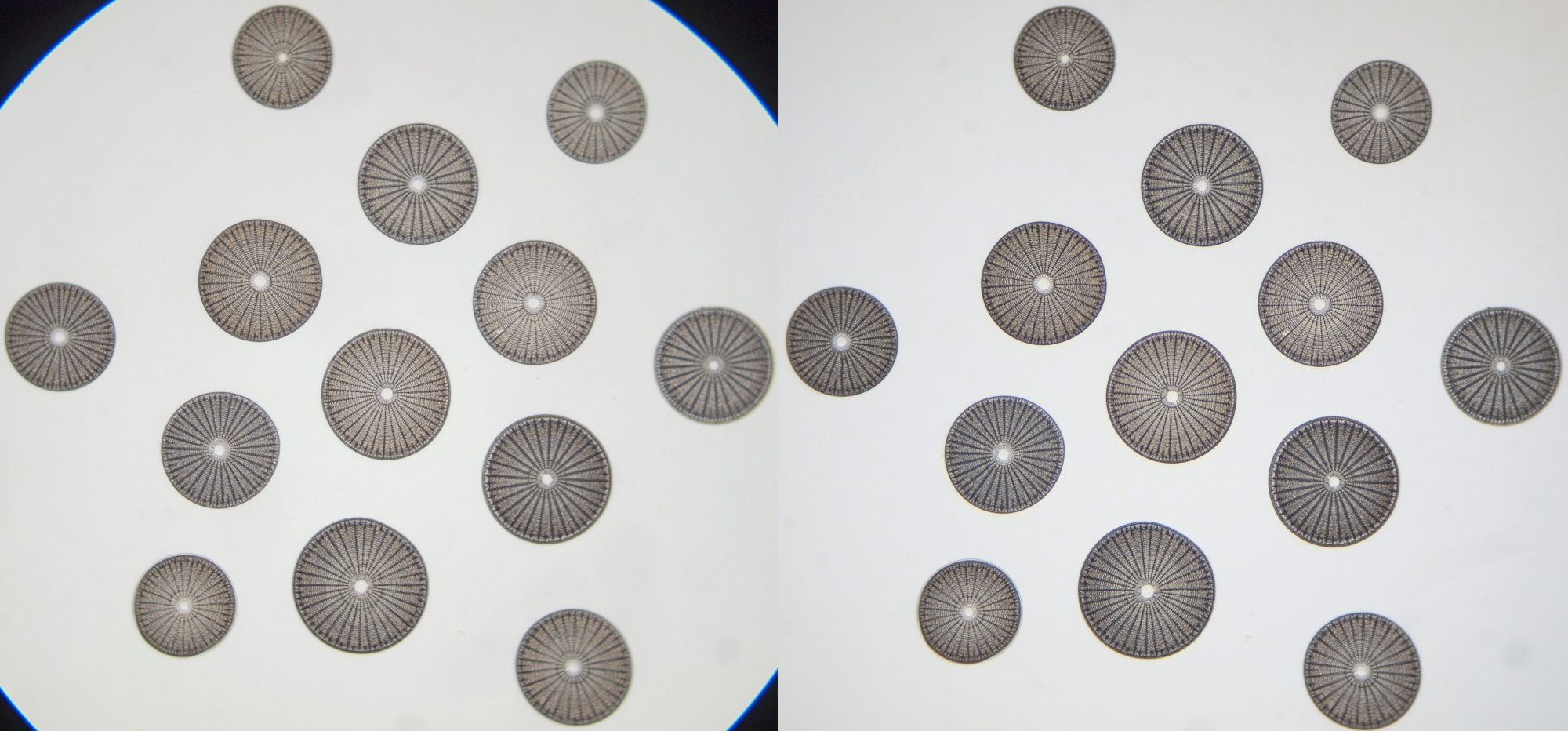Since the development of digital cameras, photomicrography has become a lot easier. You can now take an unlimited number of pictures and view the results immediately. This gives much more room for optimising the photographic settings and illumination. A good picture starts with a well optimised illumination and this is something that cannot be said often enough. It is less relevant if a simple compact camera or an expensive DSLR camera is used. And it is also not necessary to equip the microscope with objectives that have the highest correction such as (plan) apochromats. A good illumination is most important for a good quality microscope image, more than anything else.
Photomicrography is quite different from macro photography. With photomicrography we go a big step further and to make good microscope pictures, some knowledge about microscopy is necessary. When doing photomicrography, the microscope is the most important tool, not the camera. Photomicrography is not only about taking beautiful photos, it is also about the content and about gathering knowledge and information. A less beautiful microscope photo therefore does not have to be less valuable. In this section I will discuss some possibilities for photography through a microscope and what is required for this.
Finite optics and infinity optics
A distinction is made between microscopes with 'finite' optics and microscopes with 'infinity' optics. With finite optics the light rays converge after leaving the objective, with infinity optics the light rays leave the objective in parallel fashion. Finite optics was the standard for microscopes from renowned brands until about the 1990s. They then switched to infinity optics, which can be recognized by the infinity symbol (∞) written on the objectives. In contemporary unbranded microscopes and simple educational microscopes, finite optics is usually still the standard and on the objectives the number 160 is written, which indicates the mechanical tube length in millimeters. The mechanical tube length of older microscopes from renowned brands was usually 160 mm or 170 mm. For those who take up photomicrography as a hobby, microscopes with finite optics will be the most attractive, both financially and for purely practical reasons. An abundance of parts and lenses for finite microscopes can be found on the Internet, both new and second-hand, at attractive prices. Those who start working with 'infinity' microscopes often need a higher budget. The difference between the two types of microscopes can have consequences for the method of photography.
Photomicrography can be done in different ways:
1. Afocal photography: using a lens, the image from the eyepiece is projected onto the camera sensor. When we look through a microscope, the same thing actually happens: the eye lens ensures that the image from the eyepiece is projected onto the retina. Photography with smartphone, tablet, compact camera, webcam and system camera with camera lens are examples of afocal photography. When using a smartphone and compact camera, a special photo tube or trinocular microscope is not required. Here, it is possible to simply photograph through a normal eyepiece of a monocular or binocular microscope and this can be done with both microscopes with finite optics and with infinity optics. If a photo tube is available, a system camera can be used, whereby a camera lens with a fixed focal length (prime lens) is preferably used with 'finite' microscopes. The so-called Pancake lenses are very suitable for this because they are short in construction. Iinfinity microscopes with a photo-tube on the other hand are only used with the body of a system camera and no camera-objective is involved.
For good afocal photography with finite microscopes, the objective-eyepiece combination is important. See: 'The right objective-ocular combination'.
2. Projection photography: here, there is no lens between the eyepiece and the camera sensor and with a system camera only the camera body is used. To be able to photograph in this way with 'finite' microscopes, a special projective or photo-eyepiece is required that replaces the normal eyepiece. But also some regular eyepieces of the better type can be used for projection photography. Original projectives and photo-eyepieces for finite microscopes from renowned brands are often difficult to find and asking prices are high on the second-hand market. An excellent alternative are the so-called hybrid eyepieces: Photomicrography with ‘hybrid’ eyepieces. Another alternative is the use of extended eyepieces: 'Extended eyepieces as projective for photomicrography'. In microscopes with infinity optics, the image of the objective is corrected by the so-called tube lens and projected onto the camera sensor, so with this type of microscopes only a camera body or special microscope camera is used.
3. Direct projection: the image from the microscope objective is projected directly onto the camera sensor, without the intervention of other optics. There are microscope adapters without internal optics for system cameras that are placed in the tube instead of the normal eyepiece. The image from the microscope objective is then projected directly onto the sensor. The method is of limited use for microscopes with 'finite' optics because no correction of the image takes place. The method is sometimes used for macro photography where a microscope objective is connected directly to the camera via a special adapter. For this application, better corrected infinity lenses with low magnification are popular, especially the fully corrected Nikon lenses. But finite objectives with low magnification that require little correction can also be used for this purpose. Some USB eyepiece cameras do not have internal optics and are placed in the tube instead of the normal eyepiece. In that case there is also direct projection, but only a very small part of the microscope field is photographed and sometimes 'hotspots' may occur.
All these methods have their strengths and weaknesses. Which method is most suitable depends largely on personal preferences and applications. For qualitative photomicrography with 'finite' microscopes in combination with a system camera, I prefer projection photography because this method is less complex, both mechanically and optically, than the afocal method.
Smartphone
Many cameras are nowadays suitable for micro photography. Let's start with the camera that almost everyone carries around: the smartphone. The quality of smartphone cameras has improved greatly in recent years and they have even become better than some compact camera's. With a smartphone it is possible to take reasonable microscope pictures. Smartphones have a small lens and that is an advantage because a wider range of different microscope eyepieces can be used for photography. With such a small lens you can get very close to the front lens of an eyepiece. Many Huygens eyepieces have a low exit pupil, which makes it almost impossible to get near the front lens with a DSLR camera (when using a camera-objective) and have the circular field of view in focus. The entrance pupil of many system camera lenses is located quite deep and therefore does not coincide with the exit pupil of most Huygens eyepieces. Even with some compact cameras this is difficult. If you want to take pictures with such cameras, a wide-field (WF) eyepiece with a high exit pupil is needed. Using a smartphone, the edge of the circular field of view can be brought into focus with all eyepieces.
The easiest way to photograph through a microscope with a smartphone is to hold the smartphone camera above the eyepiece until you see the field of view as a sharply outlined circle. This takes some practice in the beginning, especially to keep the phone stable. The trick is to hold the middle finger of the left hand (closest to the camera lens) against the microscope tube to provide support. It is easier to photograph through a Huygens eyepiece with a low exit pupil because you can get closer to the front lens of the eyepiece. With WF eyepieces, you have to hold the smartphone a few cm from the eyepiece which makes it more difficult to support with one hand. There are special smartphone adapters that you can attach to the microscope tube and in which you can clamp the phone. This way it is possible to watch everything live on the screen of the smartphone instead of looking through the eyepiece. I use an adapter from Celestron (Basic Smartphone Adapter, 1.25”). Because a smartphone has a small sensor, the photo will not have a very large resolution, at least, compared to a system camera. The quality of the image can be further improved by using an eyepiece with a higher magnification, like for example a 15x eyepiece instead of the usual 10x eyepiece. The idea behind this is that the sensor records a smaller part of the image, so that the entire sensor surface is used for gathering information from that part. So, any details will be better recorded. Photos taken this way can be enlarged a bit more before they become "grainy". It is important to realize that fewer pixels are needed as the objective magnification increases. An image taken with a 40/0.65 objective contains less information than when taken with a 10/0.25 lens. Therefore, using higher power objectives with a smartphone will give better results.
The following images I took with a smartphone, the Samsung Galaxy A8 (SM-A530F, 16 MP, 1/2.8", 2018) and Samsung Galaxy A3 (SM-A300FU, 8 MP, 2015).
Euglena with red eyespot and cyanobacteria (Anabaena), photographed with the Samsung Galaxy A8. Carl Zeiss Neofluar 40/0.75 objective with Kpl12.5x W eyepiece.
Cells from Elodea with numerous chloroplasts, photographed with the Samsung Galaxy A3. Zeiss-Winkel 40/0.65 achromat with Olympus P15x eyepiece.
Filamentous algae (Spirogyra en Mougeotia), photographed with the Samsung Galaxy A3 using 2x digital zoom. Zeiss Neofluar 63/1.25 objective with Zeiss Kpl12.5x eyepiece.
The limitations of a smartphone only become clear when fine details have to be photographed. When an objective is chosen with which it is a challenge to resolve these details, it may be that they are poorly or barely visible with a smartphone. The following images show a comparison between a system camera and the Samsung Galaxy A8 using subjects with fine details.
Starch grains in the cells of banana photographed with the Olympus PEN E-PL1 (left) and Samsung Galaxy A8 (right). On the left, the delicate stratifications in the starch grains are more visible despite the fact that the Olympus PEN has fewer pixels. On the right, there are more overexposed areas. The Olympus PEN's larger sensor has a better dynamic range. Objective: Zeiss 25/0.45.
Pleurosigma angulatum photographed with Carl Zeiss objective 40/0.65 and Kpl12.5x eyepiece. Left: Nikon 1 J1, 10 MP. Right: Samsung Galaxy A8, 16 MP. At first glance, the photo on the right seems clearer, but this is deceiving. When zoomed in on the picture it becomes clear that the structure of the diatom is better revolved with the Nikon camera, despite the fact that this camera has considerably fewer megapixels. In most smartphones, too strong image processing is performed, which makes the photo look more contrasting and sharper, but that also leads to more artefacts in the image. When using a C8x eyepiece, the pore structure was still clearly visible with the Nikon 1 J1 camera, but with the smartphone the pores could not be visualised at all.
Pleurosigma angulatum photographed with Carl Zeiss Neofluar 40/0.75 and Kpl12.5x eyepiece. Left: Nikon 1 J1, 10 MP. Right: Samsung Galaxy A8, 16 MP. The visibility of the pores is now better than in the previous image because an objective with a higher aperture was used. The image quality of the Nikon camera however is still clearly better compared to the smartphone.
Tablet
It may not be so obvious, but with a tablet it's also possible to take pictures through a microscope. The challenge here is to hold the tablet in front of the eyepiece and it takes some improvisation to do this. If the tablet can rest on the eyepiece, this will provide the necessary stability. The pictures below were taken with the Huawei Mediapad T3, (5 Mp, 2017). The cameras in most tablets generally don't have great specs and in order to capture finer details it is necessary to use a high magnifying eyepiece, for example 15x or more, especially when using objectives ≤ 40.
Histological slides from human (left) and plant (right), photographed with the Huawei tablet. Objectives: Zeiss-Winkel 100/1.3 (left) and Zeiss-Winkel 40/0.65 (right).
A diatom like Cymbella does not have a very fine structure and can easily be photographed with a tablet. The following images show a comparison between the Olympus PEN system camera and the Huawei tablet. At first glance, the difference is barely noticeable. Only when the picture is enlarged it becomes clear that the photo taken with the Olympus camera has a higher resolution.
Comparison between the Olympus PEN (upper image) and Huawei tablet (lower image) with a slide of Cymbella. Objective: Leitz 40/0.65. Eyepieces: Leitz Periplan GF 10x (Olympus PEN) and Leitz Periplan GF 16x (Huawei tablet ).
Crops from the previous images. Olympus PEN (left) versus Huawei tablet (right). Objective: Leitz 40/0.65. Eyepieces: Leitz Periplan GF 10x (Olympus PEN) and Leitz Periplan GF 16x (Huawei tablet ).
Pinnularia (left, Olympus 40/0.65) and Stauroneis (right, Zeiss-Winkel 40/0.65) photographed with the Huawei tablet using an Olympus 15x oculair.
Eyepiece camera
Eyepiece cameras are convenient to use because they have the same diameter as an eyepiece. You can simply slide them into the viewing tubus of the microscope. Eyepiece cameras often do not contain any optical elements and only a sensor is present. This means that the image formed by the microscope objective is directly projected onto the sensor. This can be a problem for objectives that are calculated for a finite mechanical tube length. The image of many objectives calculated for a finite mechanical tube length still contains residual errors that are being removed by the eyepiece. Because the eyepiece camera replaces the eyepiece and no compensation takes place, there may be residual errors in the image. This will be more problematic with better corrected objectives and higher power achromats. The low power achromats don't need much compensation from an eyepiece, so these objectives will give the most aberration-free images with an eyepiece camera. With better corrected objectives and higher power achromats, only the centre of the image will be more or less free of chromatic aberrations. So, it's still possible to make decent pictures of small objects lying in the centre of the field of view with these objectives. The following pictures were made with a BRESSER MikrOkular Full HD eyepiece camera, a cheap camera with a small sensor. The sensor has a size of 5.86 x 3.28 mm (similar to the chips in most smartphones) and the camera has 2 Mp. You can't expect high quality images with these specifications, but then again, you don't pay much for this camera. A major disadvantage of cameras like these is that only a very small part of the field of view is recorded and that the final (empty) magnification is high. Yet, when using low power objectives it is actually better that a small part of the microscopic field is captured because more pixels will be available for the subject that's being imaged. With low power objectives, more pixels are needed. A camera like this is best used for photographing and filming organisms that occupy only a small part of the field of view, such as protists and the like.
If an eyepiece camera is used in combination with hybrid eyepieces, a larger part of the field of view can be photographed and the residual errors in the image are also corrected. See also: 'Combining hybrid eyepieces with microscope cameras'.
Stained slide of a stem, photographed with a BRESSER MikrOkular Full HD eyepiece camera. This camera has no internal optics. Shown at the right, the field of view as seen through an eyepiece with a field number of 18. The rectangle shows the tiny part that is captured with this eyepiece camera. Objective: Zeiss-Winkel 10/0.25.
Diatoms (top two photos) and ciliates (bottom photos) photographed with the BRESSER MikrOkular Full HD eyepiece camera and Carl Zeiss Apo 40/1.0. The image quality of these types of objects in the center of the field of view is reasonable.
When using an eyepiece camera without compensating optics, better results are obtained with microscopes that have infinity optics. With infinity optics, the image formed by the objective and tube-lens is already fully corrected and doesn't need compensation from an eyepiece. The next image was made with a Zeiss Axiostar (a microscope with infinity optics) by replacing one of the eyepieces in the bino-tube with the eyepiece camera. In this case, there is still only a very small part of the field of view being captured.
Cells of a moss, photographed with the BRESSER MikrOkular Full HD eyepiece camera on the Zeiss Axiostar. Objective: CP-Achromat 40/0.65.
Webcam
With a decent webcam, acceptable pictures can be taken from simple slides and subjects that do not contain many fine details. The resolution of a webcam is limited. With a webcam, the entire field of view is recorded and the number of pixels must be distributed over this area. It means that the pictures will not be great with low power objectives. With the higher magnifications it is still possible to get acceptable images and the quality of the pictures can be further improved by using an eyepiece with a higher magnification than 10x. It is best to use a widefield eyepiece (WF) with a magnification of 12.5x-15x. For purely documentation, this method is fine. I made the images below with the Logitech C922 PRO HD Stream webcam.
Pollen from a lily (left) and a mitosis slide from onion (right) photographed with the Logitech C922 PRO HD Stream webcam. Objective: Carl Zeiss 40/0.65. Eyepiece: Kpl W12.5x/18.
Left: mix of algae and fungi in a sample taken from a damp balcony. Objective Carl Zeiss 100/1.25. Right: pollen of a lily. Objective: Carl Zeiss 40/0.65. Pictures taken with the Logitech C922 PRO HD Stream webcam through a Kpl 12.5xW eyepiece.
Compact camera
With a compact camera, excellent microscope photos can be taken. The most useful are cameras with an internal zoom because there are no external moving parts. These cameras can be held close to or even against the eyepiece. I have used an Olympus Stylus 725 SW (7.1 Mp, 1/2.3" CCD, 2006) for a long time. In the beginning, I used this camera on a tripod that I placed in front of the eyepiece and that worked fine. With eyepieces that have a lower exit pupil, such a camera can be held against the eyepiece and rest on it, which also provides support.
Cells in the epidermis from Calathea rufibarba photographed with a Olympus Stylus 725 SW camera. Objective: Leitz 100/1.25.
Filamentous algae photographed with the Olympus Stylus 725 SW camera. Objective: Carl Zeiss Neofluar 25/0.60. When selecting this photo, I noticed how good the image quality is. And that for an old compact camera with only 7.1 Mp.
Left: Pollen from Alcea rosea photographed with Carl Zeiss Neofluar 25/0.60. The upper grain has burst open. Right: cells of a moss photographed with Carl Zeiss 100/1.25. Camera: Olympus Stylus 725 SW.
System camera
If you want to capture the finest details in a microscopic image, a system camera is the way to go. With 1-inch, micro 4/3 and DSLR APS-C sensor cameras, excellent micro photos can be taken. A full-frame camera is not really needed for micro photography, unless you want to make high-resolution videos. There is an important aspect in choosing a system camera for micro photography: vibrations. Cameras with a mechanical shutter mechanism can cause vibrations which results in blurry images. In micro photography, vibrations have a major impact, much more than with normal photography because of the high magnifications. I use among others, an Olympus PEN E-PL1 mirrorless micro 4/3 camera (12.3 Mp, 4/3" CMOS, 2010), a Canon EOS 600D DSLR (18 Mp, CMOS APS-C, 2011) and a Nikon 1 J1 (10 Mp, 1" CMOS, 2012). All three are somewhat older models that still work fine. The Olympus PEN causes significant vibrations when using short exposure times as this camera does not have an electronic shutter, in contrast to the other two cameras. The vibrations caused by the shutter mechanism can be greatly reduced by using longer exposure times like 2 seconds or more. When I use the Olympus PEN, I only make pictures of more or less static objects because I use an exposure time of 2.5 seconds. The Canon 600D has an electronic shutter and uses the so-called Electronic Front-Curtain Shutter (EFCS). This prevents vibrations during the exposure and the image is taken in LiveView. The mirror is first folded up (mirror lock-up) and the photo is taken before the mirror folds down. When choosing a DSLR camera for photomicrography, it is important to check whether EFCS is present. To avoid manual vibrations with both cameras, I use the self timer with a 2 second delay after pressing the button on the camera. Some Canon cameras that are very well suited for micro photography and have EFCS include the 450D, 500D, 550D, 600D, 650D, 700D and 750D. But there also more models suitable.
After choosing a particular camera, the camera has to be connected in some way to the microscope. Micro photography with a system camera can be operated with or without a camera lens. The setup without a camera lens is simpler and here a compensating eyepiece is used to project the image onto the sensor. With the Olympus PEN, I have used a Sigma 30 mm lens for a long time and that works quite well. This lens has the advantage that there are no externally moving parts when focusing, everything happens inside. This makes it possible to use the camera without the need for mechanically connecting it. The following image shows a setup with the Sigma lens that I have used a lot with horseshoe stands. The Olympus PEN camera with Sigma 30 mm lens is simply positioned on a silicon gasket that is placed on a Ihagee microscope adapter. The combined weight of camera and lens is sufficient to ensure a stable position. It is a convenient set-up for a horseshoe stand; after the photo has been taken, the camera is removed and visual observation can be continued. A second advantage of the Sigma 30 mm lens is that the entrance pupil is lying forward. This makes it possible to use any microscope eyepiece, regardless if it is high eyepoint or not. Even the most simple Huygens eyepieces can be used without any difficulties
Olympus PEN E-PL1 with Sigma 30 mm objective placed on a Olympus horseshoe stand.
With a small system camera like the Olympus PEN it is also possible to take pictures freehand through the eyepiece. This option can be considered when a binocular microscope does not have a separate photo tube. Taking pictures through the eyepiece with a real camera is easier than with a smartphone because the camera lens is usually in the middle so that positioning and centering is easier. And even more important is that a normal camera simply fits much better in the hand. When using a compact camera lens like a pancake lens, the circular field of view is photographed in its entirety or almost completely. The advantage of this is that you can see whether the camera is held correctly in front of the eyepiece, because the circle should appear exactly in the middle of the display. In addition, the edge of the circle must be in sharp focus.
Tulip pollen, photographed freehand with the Olympus PEN E-PL1 and Olympus 17mm pancake lens. Left: Zeiss Axiolab with Achroplan 40/0.65 and eyepiece E-Pl10x/20 (field number = 20). Right: Olympus FH with Olympus 40/0.65 and eyepiece WF10x (field number = 18). The eyepieces of the Axiolab have a larger field of view, so the circle is not photographed completely. The difference in type of lighting is also visible: the Axiolab has halogen lighting while the Olympus FH is equipped with LED. Halogen lighting gives slightly warmer colors.
Projection photography with a system camera
To be able to perform photography without a camera lens, a projection eyepiece (projective) or special photo-eyepiece is required that corrects the residual errors in the image from the objective and with which the image is projected onto the sensor. This applies to most objectives that are calculated for a finite mechanical tube length. However, good projectives are hard to find and sometimes they can be quite expensive. A normal eyepiece can also function as a projective when it is placed a few mm higher in the photo-tube than it is supposed to be, so it is raised. The use of a normal observational eyepiece as a projective gives varying results for the different manufacturers, varying from good to bad. It is important that a compensating eyepiece is used, also for the low power achromats. Raising an ordinary eyepiece in the tube increases the mechanical tube length of the system, which can lead to aberrations. Yet this is by no means always the case. In my experience, images that were made without a camera lens sometimes have a bit more contrast. This makes sense because there is less glass in the optical pathway, which will result in fewer light reflections. I also like this simpler setup a lot more. In this section I will describe some experiences I have with eyepieces that can be used quite satisfactory as a projection eyepiece.
When optimizing a camera setup, it is important to use an adapter that makes it possible to vary the distance between the eyepiece and the camera sensor. The ultimate goal is to get the image the camera sees more or less simultaneously in focus with the visual image: the setup is then parfocal. A very good adapter that can be found on the second-hand market is the Exakta Ihagee microscope adapter. I think this is one of the best adapters around for connecting a camera to a microscope. This part is very solidly build and it was produced in Dresden. It ensures a very tight connection with no play.
To evaluate whether the camera adaptation was done correctly, I use a object micrometer and some real slides. If the optical alignment is not correct, all kinds of aberrations will become visible. I also often use a slide with pollen because chromatic aberration is quite easily noticeable as blue colored edges around the pollen grains. Also a fresh plant slide will do, a slide from a moss leaf or the epidermis of Dracaena marginata. The latter contains very small crystals around which any chromatic aberration will be easily detected.
Zeiss-Winkel
Zeiss-Winkel made special photo eyepieces, of which I have one myself: a ‘Photo 12x’. The results with this eyepiece are reasonable, but only a small part of the microscopic viewfield is captured with it. Better results are obtained with the older Olympus WF10x eyepieces, which were intended to be used with the Olympus 37 mm objectives. I have already described elsewhere that Olympus WF10x eyepieces and the stronger Zeiss-Winkel achromats match quite well visually and for afocal photography. This is also the case when a WF10x is used as a projection eyepiece. Tests with a stage micrometer and Zeiss-Winkel 25/0.45 and 40/0.65 objectives show little chromatic aberration at the edges of the image, both when the eyepiece is placed a few mm higher in the tube and in the normal position. Reasonably good results with projection photography can also be achieved with a Wild 6xPhot and Leitz Periplan GF10x (170 mm). For projection photography with the very low power Zeiss-Winkel achromats (2.5/0.06, 4/0.10 and 10/0.25), an Olympus P10x eyepiece can be used. To maintain parfocality, the P10x eyepiece is placed at an elevated position in the tube: 2 cm higher than normal. The part of the field of view that is photographed is not that big but this also has an advantage: field curvature will not be an issue since only the part that is in focus will be captured. Moreover, additional magnification with low-power objectives is sometimes desirable, especially when using a camera that does not have many pixels.
The correction of Zeiss-Winkel objectives is very different, which means that different eyepieces or projectives are needed to get the best out of each objective. With normal eyepieces (especially the better corrected ones) reasonable to good results are obtained when they are used for projection photography. The best experience however I have with hybrid eyepieces. I have put together various combinations for Zeiss-Winkel, see: Photomicrography with 'hybrid' eyepieces.
Leaf of a moss photographed with a Zeis-Winkel 40/0.65 objective. With a Olympus WF10x eyepiece, the image was projected onto the sensor of the Canon 600D. The picture shows the uncropped image. Image width approx. 300 μm.
Carl Zeiss Oberkochen
Zeiss Oberkochen made special photo eyepieces and they were labeled ‘Fk’. For the Fk10x eyepiece that I own, the same applies as what I described for the Zeiss-Winkel photo eyepiece: results are reasonable, but only a small part of the microscopic field is captured. I found that using a normal Carl Zeiss observational eyepiece as a projective gives varying results with the objectives of Zeiss Oberkochen. When using a Kpl10xW eyepiece, for example, a strong chromatic aberration occurs at the edges of the image. I could obtain better results with a KplW12.5x eyepiece. I own a Nikon HWK10x eyepiece that gives reasonable results with eyepiece projection and Zeiss objectives. But after some experimentation I ended up with hybrid eyepieces and with these I am most satisfied. How these eyepieces are constructed is described here: Photomicrography with ‘hybrid’ eyepieces. Finally, there is one CZ lens for which it is best to use for example an Olympus P7x or P10x eyepiece if you want to do projection photography: the 3.2/0.07 objective.
Connecting the Canon 600D to a Zeiss Standard. A hybrid eyepiece is used for projection.
Water from a ditch in which mainly resting stages of Euglena can be seen. Photo taken with a Carl Zeiss apochromat 40/1.0 and oblique illumination. Without any camera optics, the image is projected onto the sensor of the Canon 600D with a hybrid eyepiece.
Leitz
There are special projectives from Leitz, but I have never found them very suitable for use in digital photography. That’s why I also constructed hybrid eyepieces that can serve as a projection eyepieces with Leitz objectives. How these are constructed is described here: Photomicrography with ‘hybrid’ eyepieces.
Adapting the Canon 600D to the Leitz Dialux II without camera objective. A hybrid is used as projection eyepiece.
Epidermis of Dracaena marginata photographed with the Canon 600D and a Leitz Planapo 25/0.65. Blurred areas are caused by differences in thickness of the specimen and therefore not all details can be simultaneously in focus. With these types of small crystals, any chromatic aberration will become visible quickly.
Stage-micrometer photographed with a Leitz Fluotar 25/0.55 objective on the Leitz Laborlux-12. Projection with a hybrid eyepiece.
Connection of the Olympus PEN E-PL1 camera to the photo-tube of the Leitz Laborlux-12 microscope. Right: Arachnoidiscus photographed with Leitz Fluotar 25/0.55.
Pollen from different plant species photographed with a Leitz NPL Fluotar 25/0.55. Microscope: Leitz Laborlux-12.
Olympus
Olympus had special projectives for photography: FK projectives for the objectives with 37 mm parfocal length and NFK projectives for the later 45 mm objectives. I use hybrid eyepieces as a projective. These give an image just as good as the original Olympus projectives.
The green alga Closterium photographed with the Nikon 1 J1 camera connected to an Olympus HSA microscope. A hybrid eyepiece (L6-P10) was used as a projective. A testate amoeba can be seen in the lower left corner of the image. Objective: Olympus F40/0.65.
Olympus P eyepieces are suited for projection photography in combination with the low power achromats (4/0.10 and 10/0.25). With both a P7x and a P10x eyepiece, good results were obtained with the aforementioned objectives. The eyepieces are placed at an elevated position which avoids strong re-focussing and parfocality is maintained. While with afocal photography the P eyepieces overcompensate the low power achromats, these eyepieces work well for projection photography.
Direct projection with a system camera
With direct projection, the image formed by the objective is projected directly onto the camera sensor without the intervention of other optics. In the case of finite optics (usually 160 or 170 mm), this method is particularly suitable for lower-magnification achromats (≤ 10/0.25). These lenses require little to no compensation from an eyepiece or projective. However, a distinction must be made here between objectives from renowned brands and generic lenses. Generic achromats ≤ 10/0.25, both old and new, require little to no compensation and can therefore be used for direct projection. For lower-magnification achromats from well-known brands such as Zeiss, Leitz, and Olympus, the period in which they were produced is important. The short achromats ≤ 10/0.25 from Olympus and Leitz (37 mm parfocal length) require little to no compensation, while the contrary is the case for the later 45 mm achromats from these brands. Only the 3.2/0.07 Carl Zeiss/Zeiss achromat can be used for direct projection, while all Zeiss-Winkel achromats ≤ 10/0.25 are suitable. The lower-magnification achromats ≤ 10/0.25 from Carl Zeiss Jena (CZJ) with a length of 33.5 mm can also be used for direct projection.
It is important to note that only achromats are suitable for direct projection. The image from better objectives, such as a (plan)fluorite or (plan)apochromat, must always be corrected with compensating optics. When direct projection is performed with better-corrected lenses, only the center of the image will look reasonable, while strong chromatic aberration will quickly become visible towards the edges. This also applies to the later 45mm achromats from Carl Zeiss, Olympus, and Leitz, because for these brands, the required correction was eventually brought to the same level for all lenses.
For other well-known brands from the past, such as Meopta, Wild, Reichert, Kyowa (and other Japanese manufacturers), the lower-magnification achromats can also be used for direct projection.
Sand from a beach in Funchal (Madeira) photographed with Zeiss-Winkel 2.5/0.06 and direct projection.
Microscope cameras
Special microscope (c-mount) cameras have a fairly small sensor, requiring a reducing lens to capture a reasonable part of the field of view. When using microscopes with finite optics, however, chromatic aberration will occur when such a reducing lens is used instead of a compensating eyepiece or projective. However, most projectives made for microscopes with finite optics have limited use because they don't reduce the image enough. A possible solution is the use of hybrid eyepieces. For the photo below I used a 5 MP camera from Touptek in combination with hybrid eyepiece C8-ZW5-Kpl10, see also: 'Combining hybrid eyepieces with microscope cameras'. With this eyepiece, the image is compensated and a reasonable part of the field of view is projected onto the sensor. The better c-mount cameras are quite expensive, but with the accompanying software all kinds of measurements and image processing can be done. However, for those who place higher demands on picture quality it is better to invest in a system camera.
Pollen of Clivia miniata photographed in oblique lighting with Touptek's 5 MP Toupcam in combination with hybrid eyepiece C8-ZW5-Kpl10. Objective: Carl Zeiss 40/0.65.
With the achromats of Zeiss-Winkel, these types of microscope cameras are still usable without compensating optics because Zeiss-Winkel achromats require less compensation than for example the achromats of Carl Zeiss. See also: The achromatic objectives from Zeiss and Zeiss-Winkel. And low power non-plan achromats (≤ 10/0.25) from other manufacturers often do not require compensation either, especially older objectives with a shorter parfocal length than 45. This is the case with Leitz- and Olympus 37 mm objectives, for example. With the current generic 160 mm microscopes, normal achromats ≤ 10/0.25 usually do not require compensation either. These cameras can be used as intended here.
Left: Zeiss-Winkel Standard Junior with 5 MP Toupcam from Touptek. Right: Arachnoidiscus, photographed with Zeiss-Winkel 40/0.65 and Toupcam.
Microscope objectives, condenser and eyepieces
The influence of the type of objective and condenser on the photographic quality is often overestimated. The quality of the slide and illumination has a much bigger impact on the final results. Moreover, it depends on the type of slide which objective makes sense to use. A larger working distance and better depth of field is often more important than a higher aperture.
Objectives with or without plan-correction?
Plan objectives correct for field curvature and ensure that the field of view is flat so that everything from the center to the edge is in focus. These objectives are preferably used with very thin slides and where there are no significant differences in thickness within the specimen, for example thin tissue sections or stained blood smears. It makes little sense to use a plan objective with a thick specimen that is not flat. In such a slide you will have blurry parts due to differences in thickness, so some parts in the field of view will be sharp up to the edge while other parts are not in focus. Plan objectives also don't have much added value for observing pond life. The price of plan objectives is considerably higher than objectives without plan correction; extra lenses are needed to correct for field curvature. But the image quality in the center of the field (this is where you usually focus on) can never be better with plan objectives than with non-plan objectives. With older plan objectives that have a less efficient anti-reflex coating, the presence of the extra lenses may become noticeable. Due to the the extra lenses, more reflections and thus stray light may be generated resulting in an image with poor contrast.
I don't use plan objectives that often, except for tests. The idea that there is so much extra glass in these objectives, just to correct for some field flatness, does not really appeal to me. I have always the following thought in my mind: what is being observed and photographed is usually lying in the center of the field and not on the edge. Furthermore, for photography I don't find it necessary to capture as much of the field of view as possible.
Achromats, fluorites or apochromats?
It is a myth to think that you need expensive and highly corrected objectives for micro photography. In principle, you don't need anything else than good quality achromats. With normal achromats, excellent images can be obtained. See also 'Praise for the humble achromat'. Anyone who cannot achieve satisfactory results with ordinary achromats is doing something wrong. There is always a compromise between depth of field and resolving power and it is important to consider which objective is useful for a particular type of specimen. A high resolution apochromat places high demands on the quality of the slide. The higher the resolution of the objective, the shallower the depth of field will be. It can happen that the image of an apochromat turns out to be extremely disappointing because the quality of the slide leaves much to be desired. And as already mentioned earlier, some planapochromats contain many lenses which can result in poor contrast, especially with older objectives.
If you want to use better corrected objectives, then in my opinion the fluorites (such as the Zeiss Neofluar and Leitz Fluotar objectives) are a very good choice. In general they give images with more contrast than apochromats and less chromatic aberration than achromats.
In my opinion, fluorites and apochromats will never be a complete substitute for achromats because the latter have a greater depth of field and working distance.
The condenser
Sometimes it is said that an achromatic condenser is recommended for color photomicrography. Perhaps there was some truth in this in the pre-digital era, but nowadays the impact of software to improve the colours in the image is many times greater than the achromatic correction of a condenser. Most microscopes are equipped with a two-lens Abbe condenser that has no correction. This condenser is well suited for nearly all purposes. The influence of an achromatic and aplanatic condenser on the quality of the image is being overestimated, it is important to realise that a condenser does not actually contribute to the creation of the image. Highly corrected condensers are expensive and in many cases they do little to improve the image. These types of condensers will only be useful in very critical and high-resolution microscopy where the maximum resolving power must be achieved.
The eyepieces
Many different types of eyepieces exist. For photography it is important that a distinction is made between compensating eyepieces and eyepieces with less or no correction. It is recommended to use a compensating eyepiece for high power achromats (>20x), all planachromats, (plan) fluorite and (plan) apochromates. With many low power achromats (10x and less), the situation is a bit more complicated which I will explain later. Compensating eyepieces are often marked with a 'C', K, 'P' or other letter combinations that indicate the word 'Foto/photo' or 'Kompensation/compensation'. Sometimes however, there are no markings that indicate if the eyepiece is a compensating one. An example of that are the Olympus WF eyepieces, the ones that were used for objectives with 37 mm parfocal lenght. These eyepieces are labeled 'WF' only but they are indeed compensating and recommended for photography. When in doubt, it is wise to look up the optical specifications given by the manufacturer. It is always important to judge the microscope image critically. How does the image look on the edge: is there any chromatic aberration or distortion visible? In case of a mismatch between objective and eyepiece, chromatic aberration and distortion occur mainly at the edge of the field of view. In general, best results are achieved with objectives and eyepieces from the same manufacturer. But there are many exceptions to this. What's most important is to use a compensating eyepiece for objectives that need correction. Most of the time, a 40/0.65 achromat for example, will give a better image with a compensating eyepiece from another manufacturer than with a non-compensating eyepiece from the same manufacturer. And no-name microscopes often come with eyepieces that barely compensate. See also: 'The right combination of objective and eyepiece'.
Photography with low power objectives
A number of older achromats with magnifications ≤ 10x (without plan correction!) of renowned brands often require little to no compensation. For afocal photography with these objectives, it is best to use an eyepiece that hardly compensates. However, the opposite is the case when projection photography is done with a normal eyepiece (not a projective), a compensating eyepiece is then required. This applies in any case to Olympus and Leitz objectives with 37 mm length, Zeiss-Winkel and the 3.2/0.07 achromat from Carl Zeiss.
In the next experiment I photographed white sand with an Olympus 4/0.10 objective (37 mm parfocal length), both with projection and afocal method. For both methods I used an eyepiece that hardly compensates (Olympus 10x) and a compensating eyepiece (Olympus P10x). The images were taken with the Olympus PEN E-PL1 and a Sigma 30 mm lens was used for the afocal method.
White sand photographed with both afocal method and projection using an Olympus 4/0.10 achromat. Top left: afocally with Olympus 10x eyepiece. Bottom left: afocally with Olympus P10x eyepiece. Top right: projection with Olympus 10x. Bottom right: projection with Olympus P10x. The best results are achieved via projection photography with an Olympus P10x eyepiece. Both plan correction and contrast are best here. The differences are most clearly visible at the edges.
Crops of the left edge of the original photos. From left to right: afocally with Olympus 10x, projection with Olympus 10x, afocally with Olympus P10x, projection with Olympus P10x. Here, chromatic aberration is clearly visible in the less ideal combinations in the form of blue color artifacts. The artifacts are especially visible when an Olympus 10x eyepiece is used for projection.
Good results with projection photography are achieved with compensating eyepieces of various brands. Examples include Olympus P-eyepieces, Leitz Periplan eyepieces and Carl Zeiss Kpl8x eyepieces. The eyepieces are placed at a raised position in the tube which maintains parfocality. The following photo shows a comparison between afocal photography and projection photography with an Olympus 10/0.25 objective.
Arachnoidiscus photographed with Olympus 10/0.25 objective. Left: afocal with Olympus 10x Huygens eyepiece and Sigma 30 mm camera lens. Vignetting occurs here. Right: projection with Carl zeiss Kpl8x eyepiece where the height of the camera was adjusted until the camera sensor was fully exposed. The results of both methods are comparable, perhaps slightly better plan correction and contrast with Kpl8x eyepiece.
Image editing
Structures and details in microscope pictures can be greatly enhanced with image processing software. Especially contrast enhancement does a lot. For processing pictures I use the program RawTherapee but I am quite careful with image editing. Mainly white balance, contrast and brightness are adjusted in moderation. I believe that an image should look pretty good from the start, without any editing. It is fine to remove any annoying spots in the image caused by dust particles that have settled on a lens or the camera sensor. Personally, I'm not in favor of erasing certain details in a photo just to make the subject in question look nicer. For example, if a picture shows algae that are surrounded by bacteria, then I think those bacteria simply belong there. These are the algae in their natural habitat that they share with other organisms. In my opinion, it is the different sizes and shapes of different organisms in the same image that gives much more meaning to that image.
The DIC hype and stacking obsession
Nowadays, everyone seems to want a microscope equipped with differential interference contrast (DIC). And then only present photos that were taken with DIC. It creates too much uniformity on forums, normal brightfield images are shown less and less. The question is whether this is because people have forgotten how to take good brightfield images or because brightfield is seen as inferior. The latter is pure nonsense. Every illumination technique shows different information and DIC is just one of those techniques. Every DIC image should actually be complemented with a brightfield image. Moreover, a similar effect can be achieved with oblique illumination as with DIC. Good oblique illumination is better than bad DIC and we already see enough of the latter.
With transmitted light microscopy, stacking multiple images over the entire depth of an object is also very fashionable. The aim of this is to be able to sharply image a spatial object in its entirety. Stacking now seems to be taking on obsessive forms. People often do not realise that with many transparent objects (typical for transmitted light microscopy) the image is completely ruined because of stacking. Everything is depicted sharply and all structures that are spatially at different depths are on top of each other, while a living transparent object is 3-dimensional. With images that are not stacked, structures that are deeper are depicted less sharply, which gives a spatial impression and a more realistic perception of the shape of an object. In addition, with stacking many artefacts due to movements in a living organism are added together, which does not benefit the quality of the photo. Stacking is particularly useful for photography of non-transparent objects with incident light. This can be used to make beautiful recordings of insects, among other things.
The principle of simplicity
On my website I try to emphasize as much as possible that good results can be achieved with relatively simple and not too expensive equipment. I am convinced that a lot is possible with a small budget. When you start with this hobby, you don't want to spend a lot of money right away. I always keep this in mind when giving advice to people to whom all this is new. It is a big misunderstanding to think that expensive cameras and advanced microscopes are necessary for decent photomicrography. This is also discussed in the article 'Getting the best out of a basic microscope'.
For those who are willing to purchase used equipment there are lots of possibilities. Good compact cameras and system cameras can be found on the second-hand market for 50-150 euros and you actually don't need more than a camera body. It's also important to realize that for photomicrography, in most cases, you don't need many megapixels. With 5-10 Mp you can obtain good quality pictures, especially at higher magnifications.
On forums you regularly see people who want to start with photomicrography and who immediately want to buy an expensive microscope with the best optics. Sometimes they are encouraged by 'experienced' microscope users, especially those who manage to produce mediocre to poor images with the most expensive equipment. That's not how it works. There is a learning curve and it's best to start with basic equipment. Moreover, it is much more satisfying to achieve good results with simple equipment and to constantly come up with something to improve these results. A very educational process. Less is more!
